Lore:Statues/Notable Figures
Statues of historical and notable figures can be found across Tamriel and can serve as a visual representation of not only them, but also events from the past. They allow numerous races to remember and celebrate the lives and achievements of their great leaders, heroes, and figures who have contributed to the progress of their society. Additionally, these statues can serve as a reminder of the challenges and struggles faced by their ancestors and the sacrifices they made.
Statues of notable figures can be found in the settlements of almost every race, They act as a symbol of pride and help to create a shared sense of identity and belonging. Often their greatest heroes are immortalized in stone, including Frandar Hunding for the Redguards, Ysgramor and Harald for the Nords, Tiber Septim and Alessia for the Imperials, Torug gro-Igron for the Orcs, and so forth. Many statues of notable figures from the distant past are subject to scholarly study and can shed light on aspects of their lives that were previously lost to time, or in some cases ignite heated debate in among scholars.
Notable Figures[edit]
Contents
- 1 Notable Figures
- 1.1 Alessia
- 1.2 Anahbi
- 1.3 Antus Pinder
- 1.4 Arthosiis
- 1.5 Baloth Bloodtusk and Gaiden Shinji
- 1.6 Bendu Olo
- 1.7 Brazzefk
- 1.8 Byric
- 1.9 Champions of the Blessed Crucible
- 1.10 Durak gro-Batul
- 1.11 Durcorach
- 1.12 Ettiene Volusus
- 1.13 Frandar Hunding
- 1.14 Ghelin-Brol
- 1.15 Gray Fox
- 1.16 Hubalajad
- 1.17 Ja'darri
- 1.18 Jaiv-Yora
- 1.19 Katariah
- 1.20 Khunzar-ri
- 1.21 Martinne Guimard
- 1.22 Morihaus
- 1.23 Morkuldin Trio
- 1.24 Nemfarion
- 1.25 Order of the Hour
- 1.26 Pelagius I or IV
- 1.27 Reman
- 1.28 Rislav the Righteous
- 1.29 Sai Sahan
- 1.30 Savior of Bruma
- 1.31 Shalidor
- 1.32 Thassad II
- 1.33 Topal the Pilot
- 1.34 Uriel Septim III
- 1.35 Valentis
- 1.36 Vanus Galerion
- 1.37 Vashu-Pir
- 1.38 Viridian Sentinel
- 1.39 Ylgar and Yngol
- 1.40 Ysgramor
- 2 Notes
- 3 References
Alessia[edit] |
|
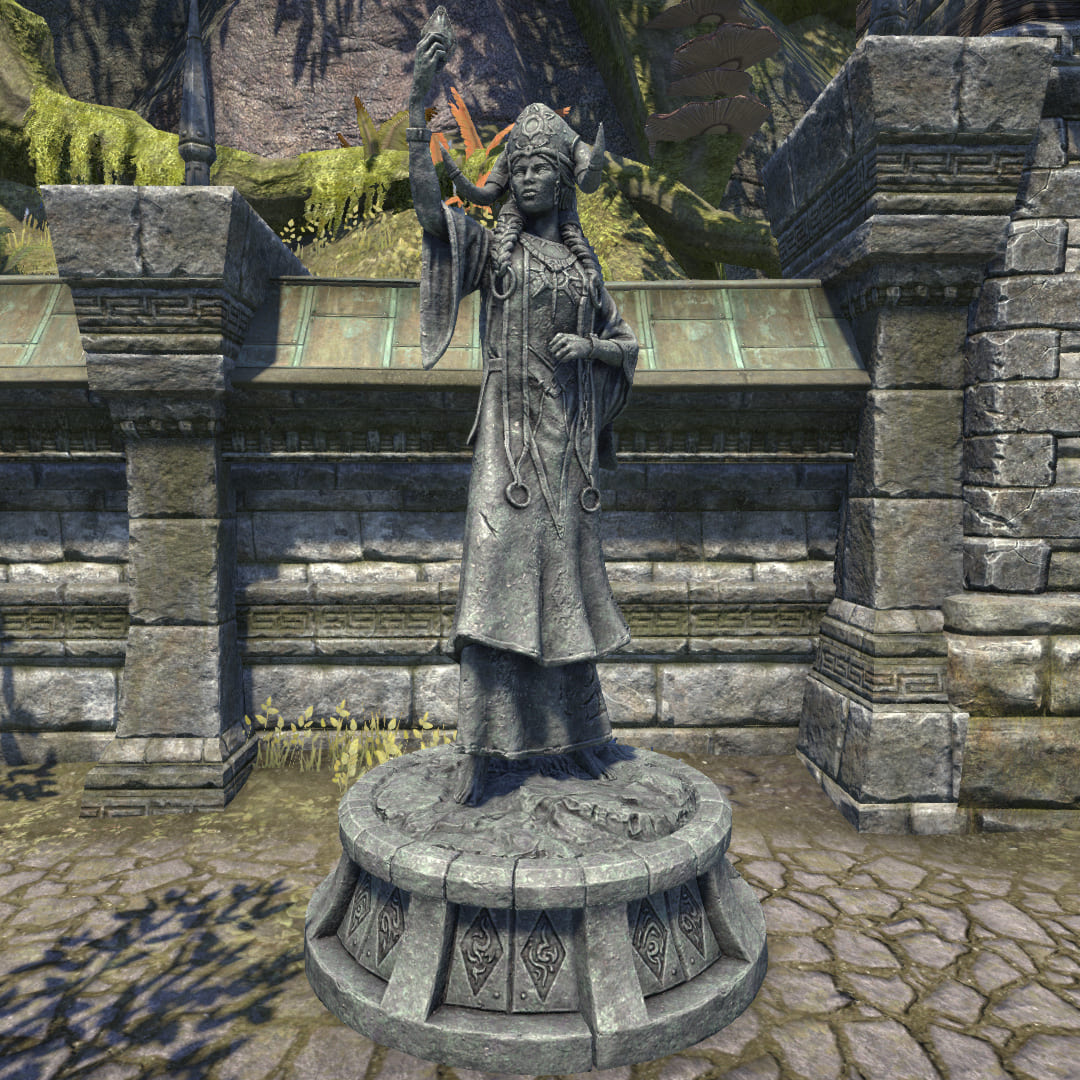 ESO |
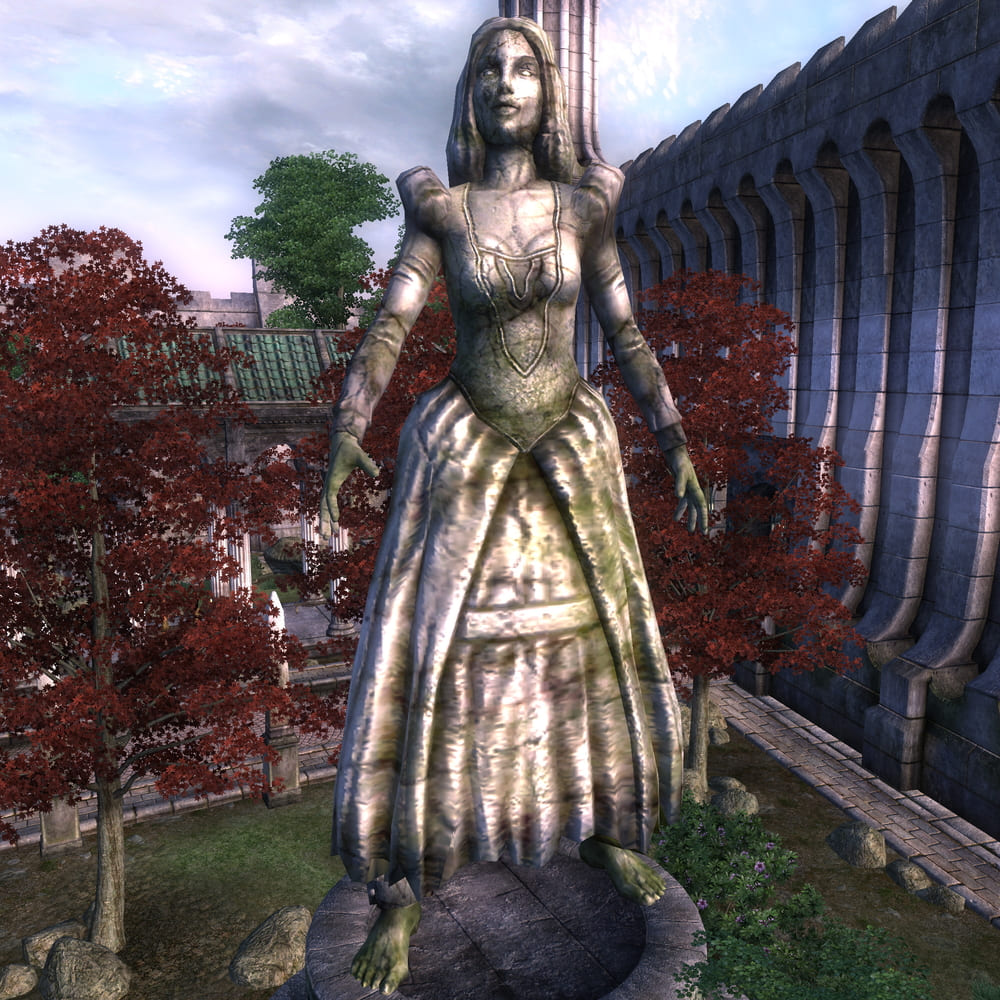 Oblivion |
|---|---|
|
A statue of Saint Alessia, mother of the First Empire, was uncovered in the mid-Second Era by the Antiquarian Circle in Grahtwood. This discovery was of particular note, given the Alessian Order had placed tight restrictions on graven images of Alessia and historians have never fully known what she really looked like. The statue depicts her bearing the shackles from Ayleid enslavement as she holds aloft the Amulet of Kings.[1] |
During the late-Third Era, a large statue of Queen Alessia could be seen in the Arena district of the Imperial City.[2]:344 While she still wears shackles as seen in older statuary, she is depicted wearing a dress as opposed to robes.[3] |
Anahbi[edit] |
|
|
A statue of Anahbi, an ancient thief from Quin'rawl, could be found in her trap-littered tomb beneath the Redfur Trading Post. The statue functioned as a locking mechanism as her reliquary was rumored to contain untold riches, which led many treasure hunters to perish in the relentless gauntlet that guards them. Her prized treasure was, in fact, an amulet containing Jone's Tear, a jewel cut from a Varla Stone by a legendary First Era jeweler.[4][5] |
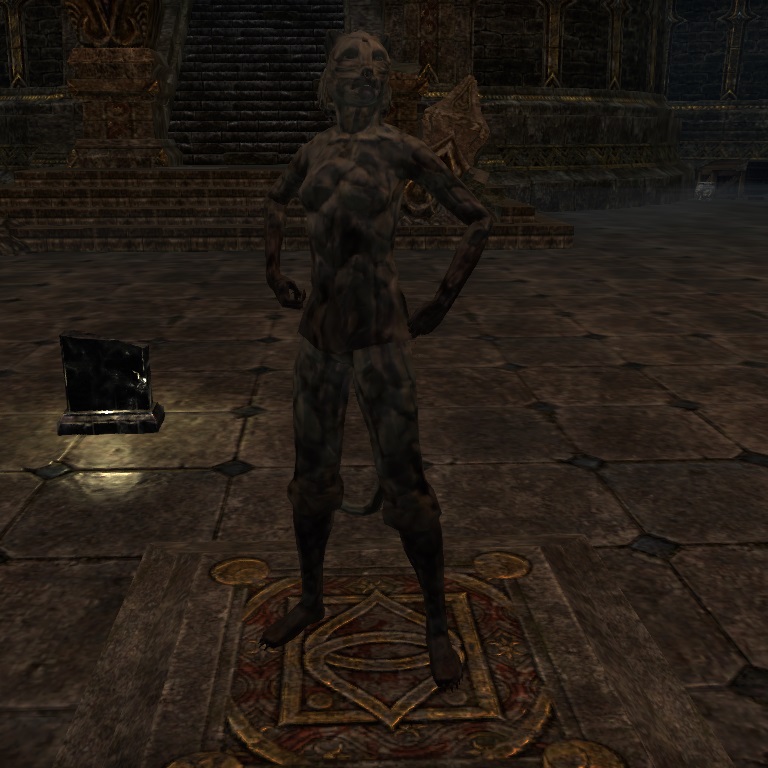 ESO ESO |
Antus Pinder[edit] |
|
|
At the center of Kvatch stands a statue of Antus Pinder, a hero who led the defense of the city against a superior force.[6] It's unclear who this superior force refers to, but what is known is that the statue was built at some point between the mid-Second Era and the late-Third Era.[7] This fact narrows down the number of conflicts this statue stands to commemorate. Arguably the most notable conflict Kvatch endured during this period was invasion of western Tamriel in 3E 249, where the city was brutally sacked.[8] Despite being defeated gravely, a statue of Antus Pinder was erected to remember his courage and spirit.[6] |
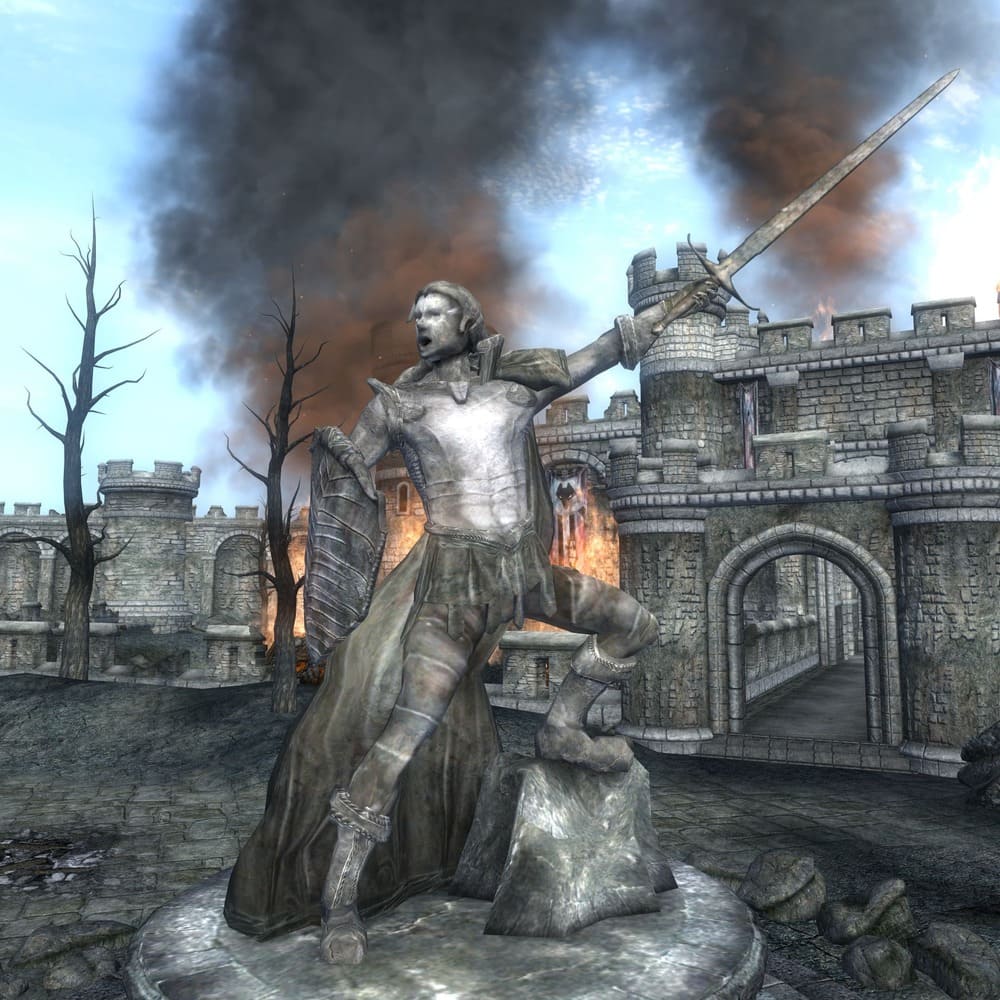 Oblivion Oblivion |
Arthosiis[edit] |
|||
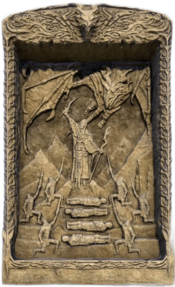 ESO |
 ESO |
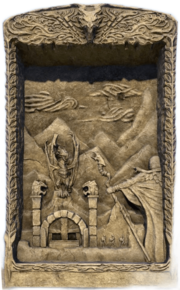 ESO |
 ESO |
|---|---|---|---|
|
Four bas-reliefs found in Exile's Barrow in Wrothgar tell the tale of an ancient Dragon Priest known as Arthosiis. The story begins with the priest surrounded by his devoted followers, swords raised in a celebration of some sort around the time of the Dragon War. The next panel depicts a Dragon, the priest and his followers leaving Skyrim in an exodus to Wrothgar, likely as a result of losing the war after Alduin's banishment. Next is shown the exiles building a grand temple for the dragon and his priest. The last panel is named "Ascension" and shows that after the dragon died, the priest killed himself and his followers sealed themselves in this barrow.[9][10] |
|||
Baloth Bloodtusk and Gaiden Shinji[edit] |
|
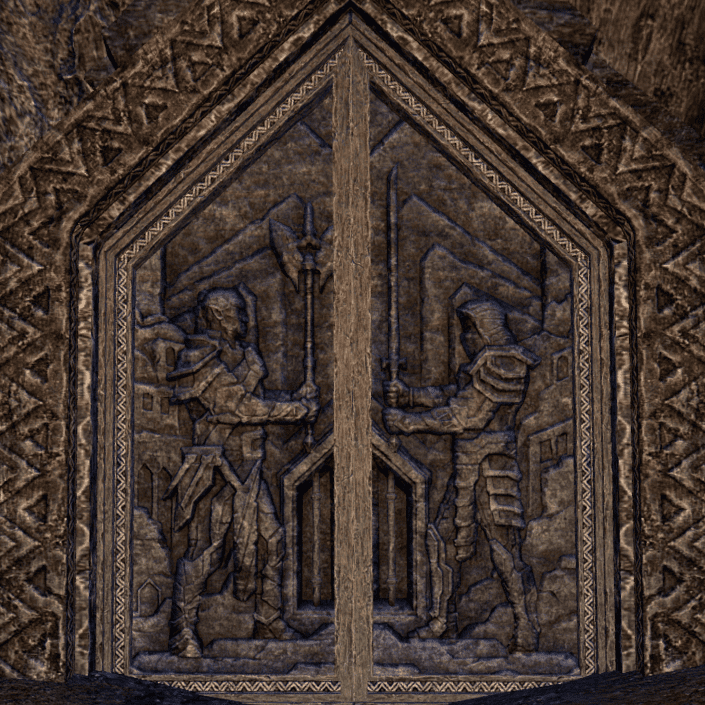 ESO |
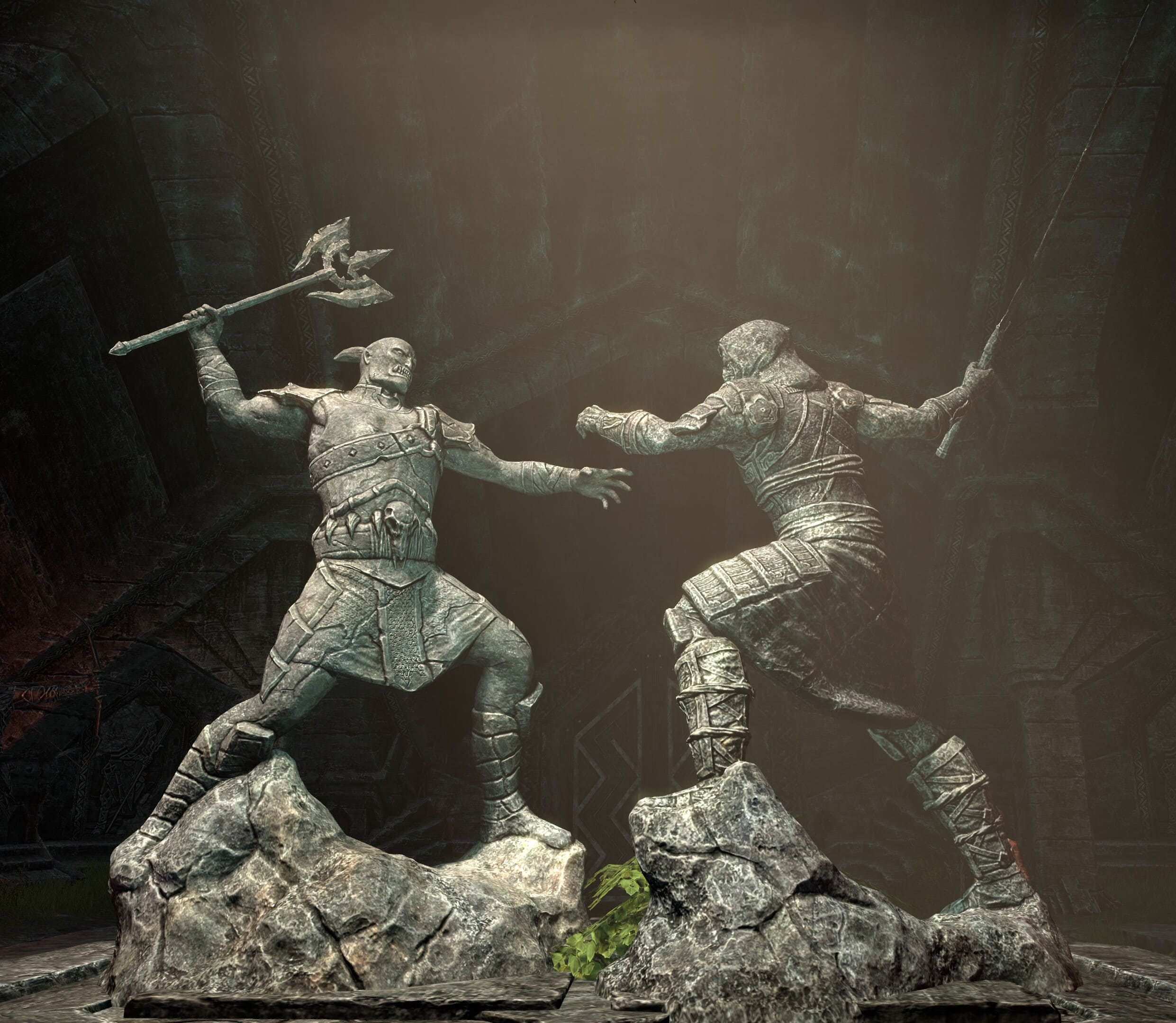 ESO |
|---|---|
|
Honor's Rest in Wrothgar serves as the tomb of Baloth Bloodtusk and Gaiden Shinji, two great heroes and rivals, buried together side by side. It is here various depictions of both heroes and their epic duel in the First Era can be found.[11] The duel came about after King Joile manipulated Shinji into having a duel with Bloodtusk to decide the fate of their war on Orsinium. The duel was in fact a ruse set up by King Joile to assassinate Orsinium and Hammerfell's greatest champions and leave them weakened. The plot was largely successful, leading to both heroes being cut down in the middle of their duel. After their deaths, Bloodtusk's brother Rakoug and Shinji's friend, Lord Trystan discovered King Joile treachery and decided to build them both a tomb in western Wrothgar. The tomb was built by Orcish, Redguard, and Breton masons after the destruction of the First Orsinium. Although it was primarily Orcish in design, Redguard and Breton statuary could be throughout the tomb.[12] However the fate of both heroes and the location of the tomb was lost over centuries.[13][14] Of note was the large door of the tomb that featured depictions of Baloth and Shinji. Deeper in the tomb a grand statue immortalizing the sacrifice of both warriors could be found, locked in battle. The tomb was discovered in 2E 582 by a pair of scholars who disagreed on whose tomb it was. With the help of the Vestige, they managed to unseal the tomb and experienced visions of Gaiden Shinji's and Baloth Bloodtusk's final moments during the Siege of Orsinium, and discovered the tomb belonged to both heroes.[12] |
|
Bendu Olo[edit] |
|
|
The Colossus of Gonfalon Bay is the name given to three-hundred foot statue dedicated to Baron-Admiral Bendu Olo. Built in the harbor of Gonfalon Bay in High Isle, it is known simply as the Colossus to High Islanders and is seen as both a wonder and a source of pride for the citizenry, and gives a sense of comfort to all who fall beneath its gaze. According to legend, as long as the Colossus stands, no harm will ever befall High Isle or the Systres archipelago.[15] The Colossus started life as an idea for the primary monument for the All Flags Navy after the remnants of that massive fleet returned to High Isle. Bendu Olo initially rejected the plans for the monument because he wanted it to honor all the ships and sailors that made up the All Flags Navy, and not just him. The plans for the Colossus were set aside while the monuments on the All Flags Islet were constructed. As the monuments were nearing completion in 1E 2274, it was decided Bendu Olo had to be properly recognized for leading the All Flags Navy against the Sload. A massive, jagged rock jutting out of Gonfalon Bay was selected, and a team of expert stone carvers and craft-mages were assembled to turn the looming peak into a work of art. The dedication ceremony and unveiling took place in 1E 2290. Elderly and in failing health, Bendu Olo nevertheless made the trek from Anvil to accept the honor. While most High Islanders continued to look upon the great Colossus with a sense of awe and wonder, by the mid-Second Era few actually knew the history behind its construction or what the statue actually represented. [15] |
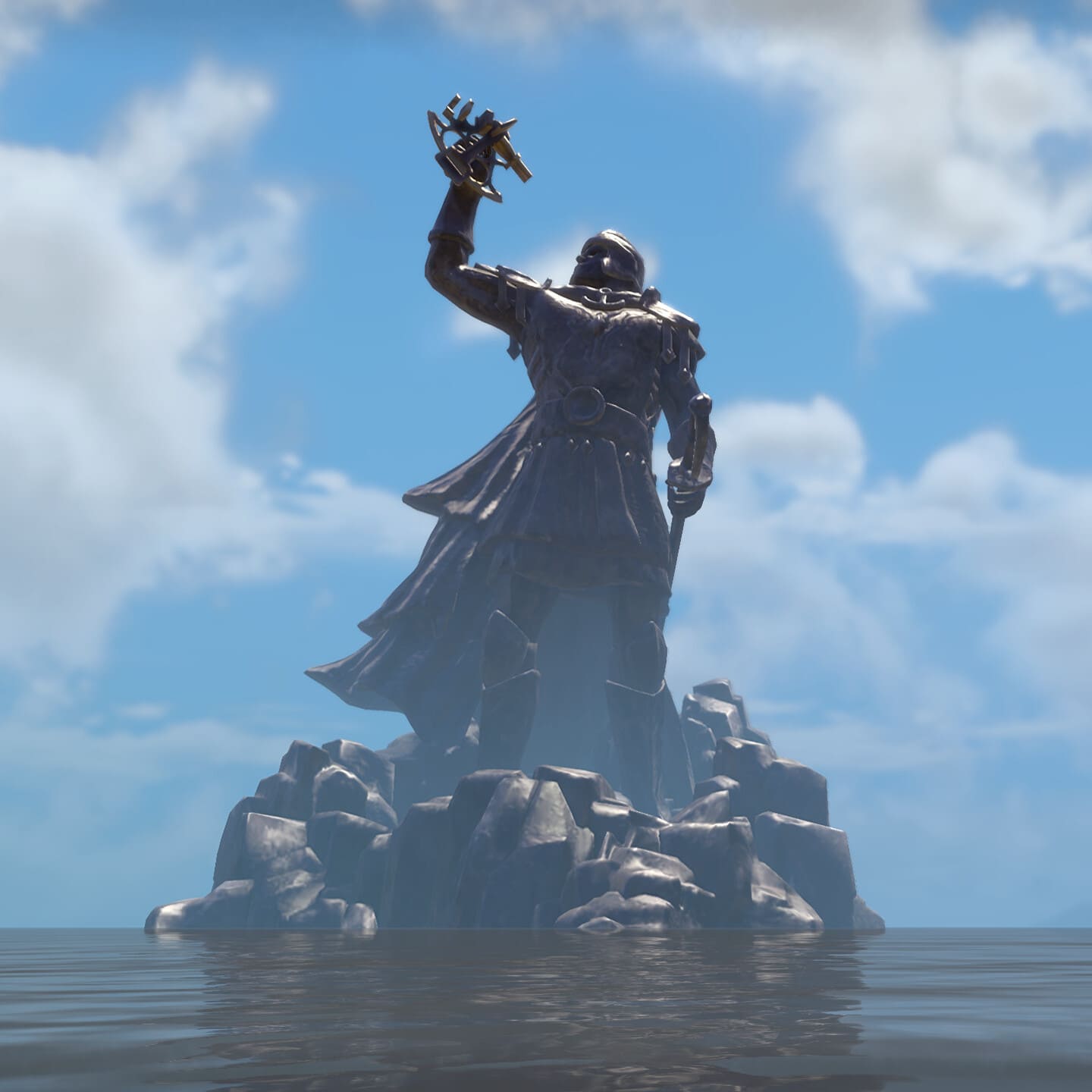 ESO ESO |
Brazzefk[edit] |
|
|
According to legend, Brazzefk was a Dwemer alchemist of great renown. His search for immortality culminated in him creating a potion designed to turn him into a living giant of stone, free from the failings of flesh. The potion was said to have worked all too well, turning his entire body into a statue, immortal but immobile. Around 2E 582, the supposed head of the Brazzefk's statue was displayed in the Endarwe's Museum of Wonder and Antiquities in Rulanyil's Fall. Speculation arose among its members if this was indeed head of Brazzefk and if he was still aware of his surroundings.[16] |
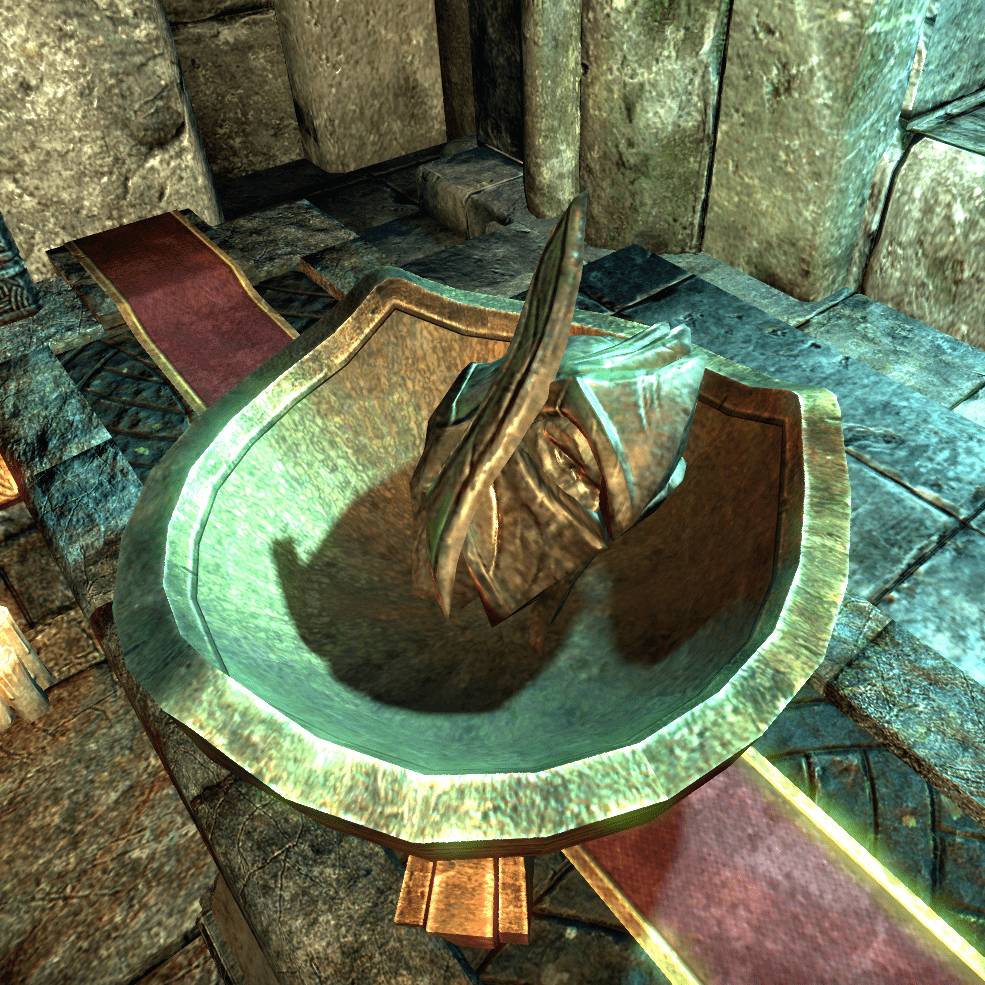 ESO ESO |
Byric[edit] |
|
|
A statue dedicated to Sir Byric was built in the grounds behind Alcaire Castle during the mid-Second Era. It was built to commemorate his actions against Reachmen invaders in 2E 542, when he set fire to the fields surrounding Alcaire Castle and successfully held back the invaders. The Alcaire Knights were renamed Knights of the Flame to honor his bold action and determination.[17][18] |
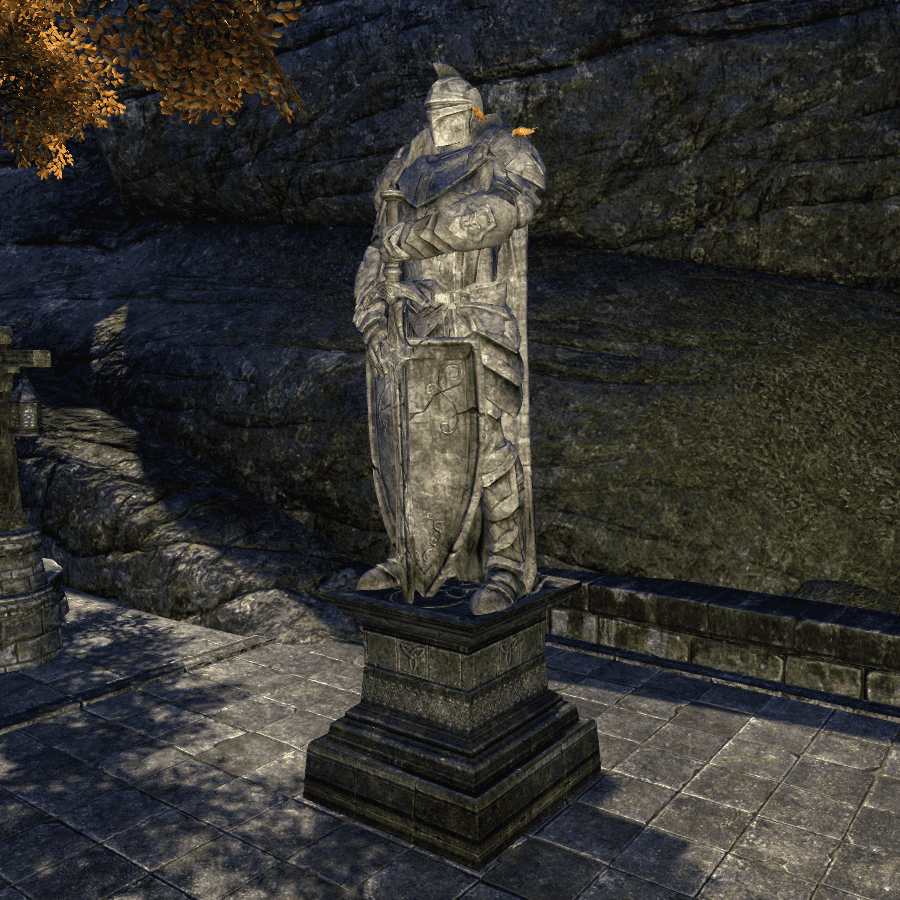 ESO ESO |
Champions of the Blessed Crucible[edit]Ten statues of ten previous champions stood in an antechamber inside the Blessed Crucible in the Rift. |
||||
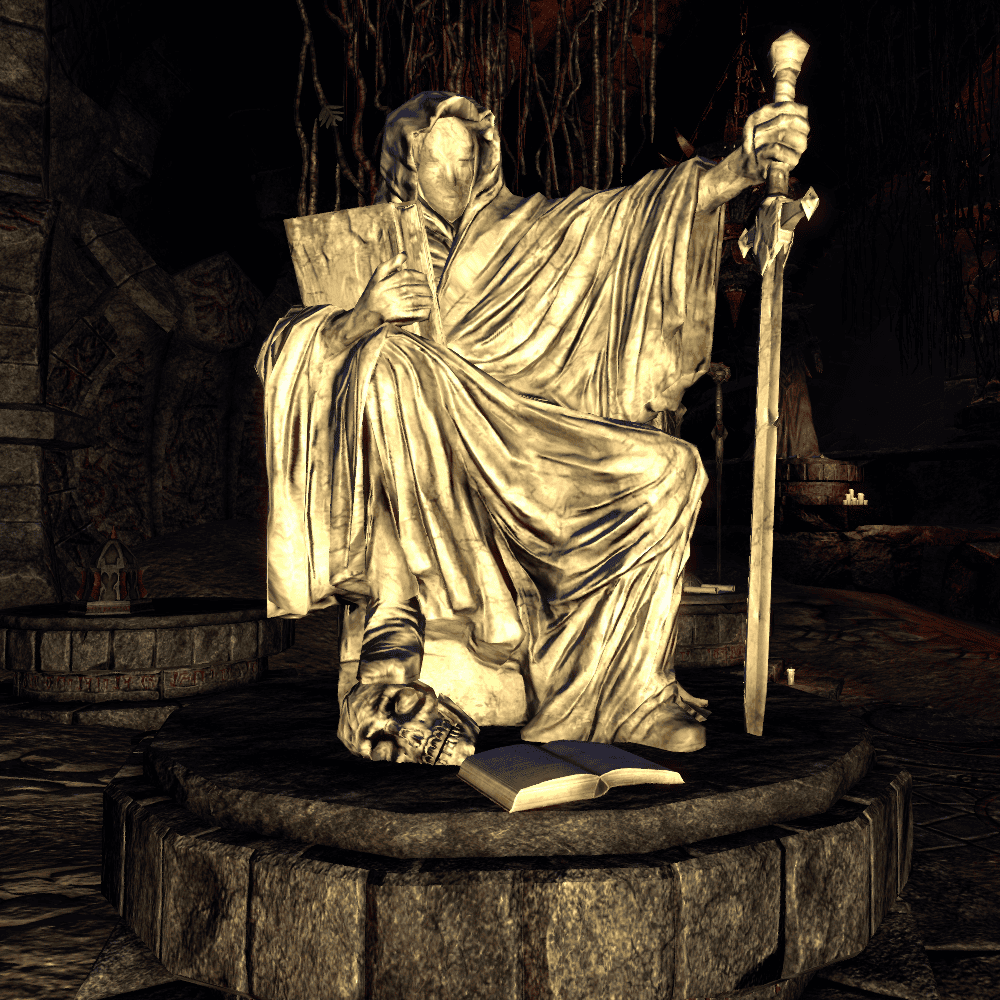 Aleris the Shroud, ESO Aleris the Shroud, ESO |
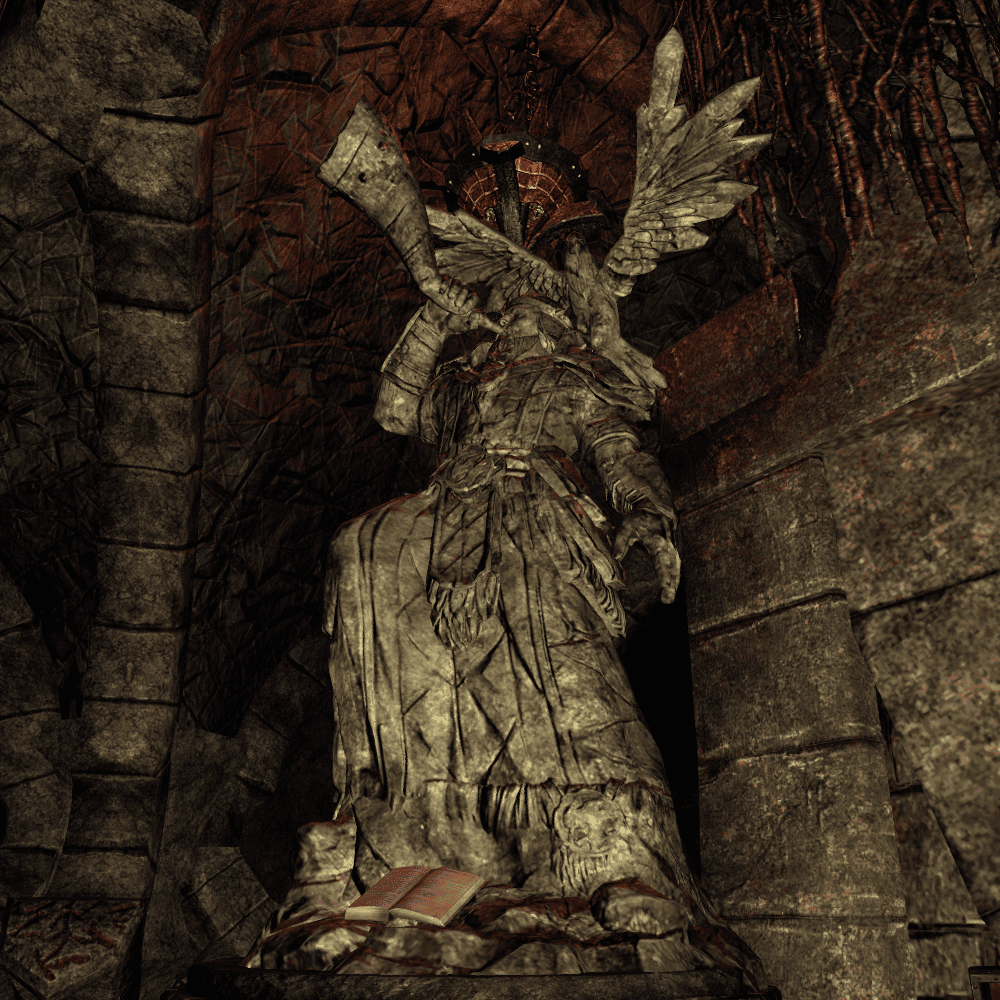 Crow Bringer, ESO Crow Bringer, ESO |
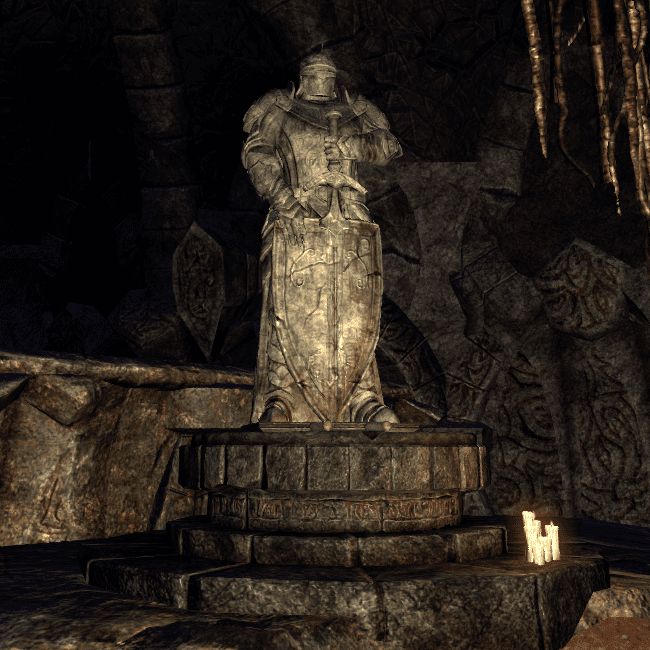 Hagrof the Righteous, ESO Hagrof the Righteous, ESO |
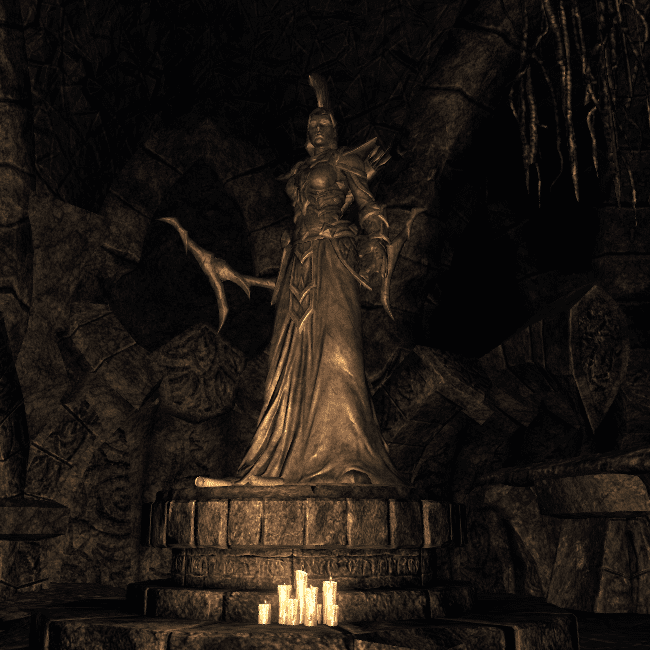 The Thousand Arrow, ESO The Thousand Arrow, ESO |
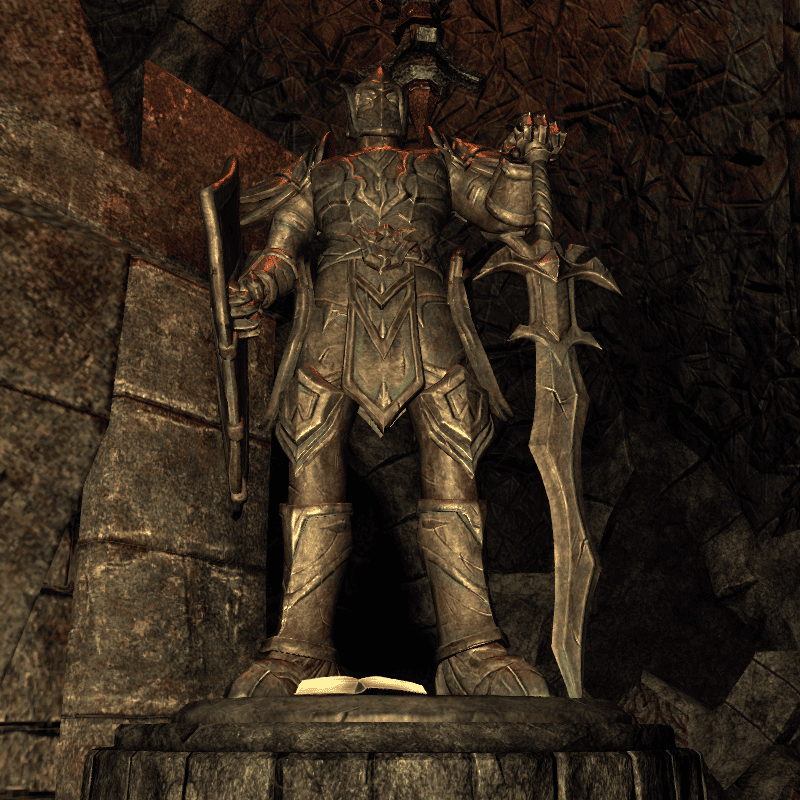 Lucius the Stalwart, ESO Lucius the Stalwart, ESO |
|---|---|---|---|---|
|
Aleris, the first Champion of the Blessed Crucible, held the title for four decades. She was renowned for her skill with illusion magic and her deft swordplay. Few were able to match her skill in the arena or her favor with the crowd.[19] |
Crow Bringer was said to possess the powers of the Hagravens, allowing him to transform into a murder of crows and attack his foes from a hundred directions at once. His reign as Champion would be cut short by Hagrof the Righteous, who utilized the powers of light, incinerating the crow forms.[20] |
Hagrof was known for his honor, humility, and respect for his fellow gladiators as Champion. He was known to honor his vanquished foes with proper burials in accordance with the customs of their people. When he was finally defeated, it is said that the gladiators of every race stood in silent salute, then carried his body to an ancient pyre and gave him a funeral worthy of a Nord king.[21] |
The Thousand Arrows bested all the other gladiators with skill and precision and didn't suffer a single wound herself. After Hagrof the Righteous fell, the Thousand Arrows remained in seclusion, only emerging when a new challenger entered the arena. Her favored weapon was a bow equipped with poison-tipped arrows of her own creation, the recipe of which is hotly debated by alchemists to this day.[22] |
Lucius the Stalwart was the protege of Hagrof the Righteous. Initially, a scholar who was hired to write Hagrof's legacy, he flew into a rage at the loss of his mentor and swore to avenge him. The fight between Lucius and The Thousand Arrows was long and bloody. In the end, Lucius' ability to withstand the champion's poison allowed him to claim victory, but the process left him permanently weakened.[23] |
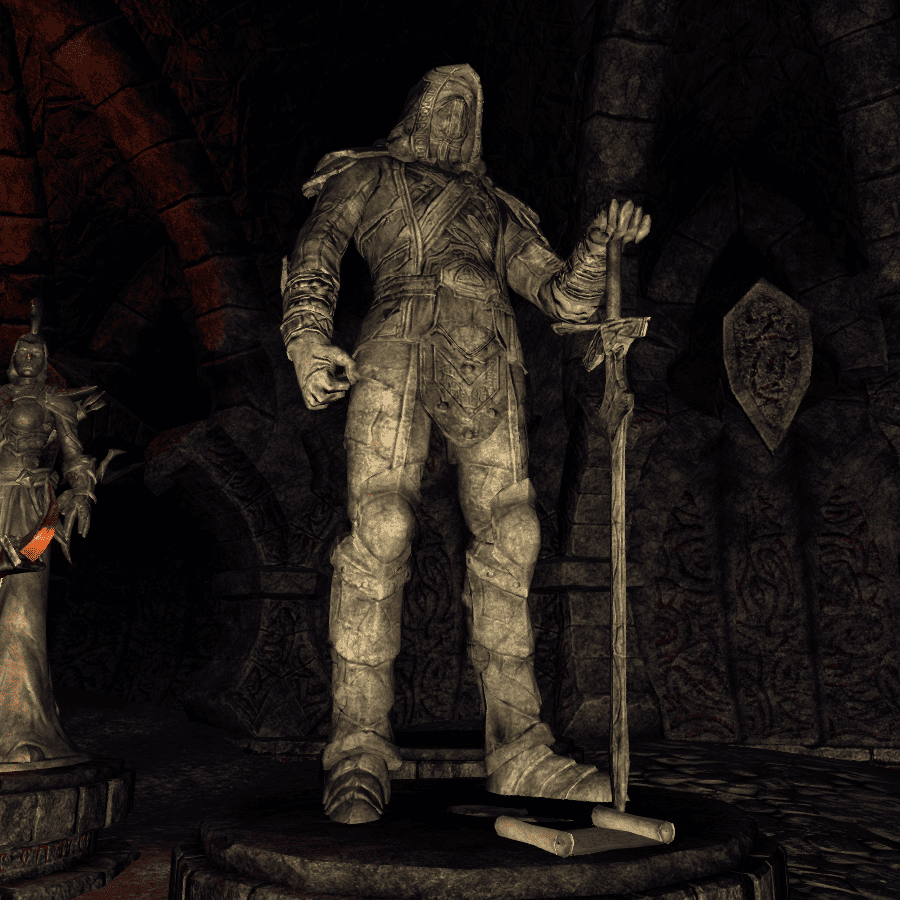 Whitebear, ESO Whitebear, ESO |
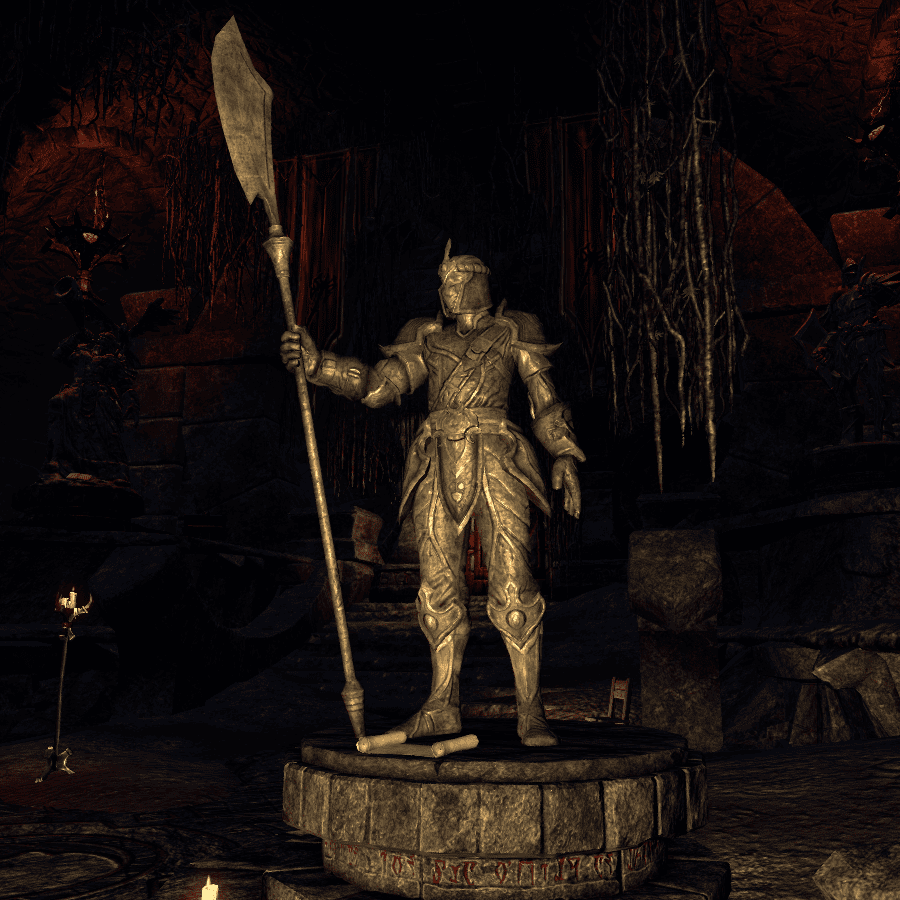 Ferian Darkstorm, ESO Ferian Darkstorm, ESO |
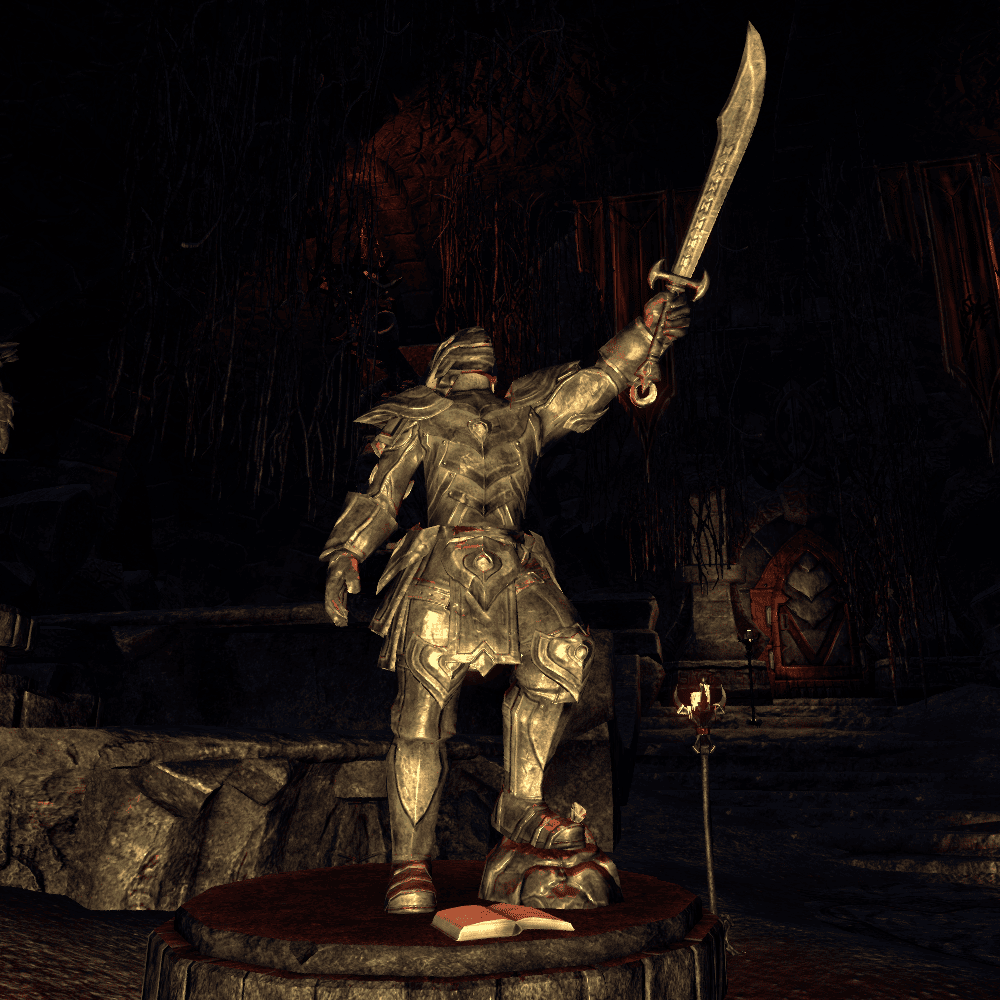 Felhorn, ESO Felhorn, ESO |
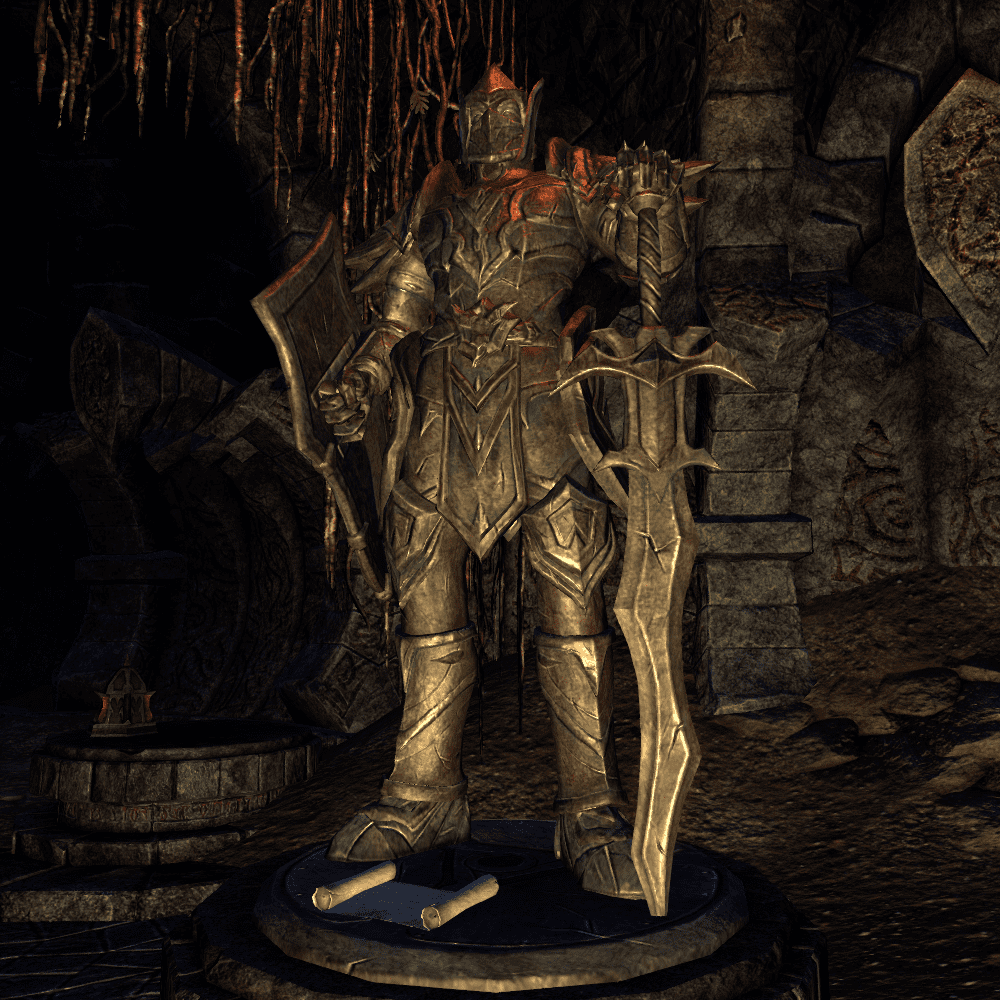 Sanarel the Great, ESO Sanarel the Great, ESO |
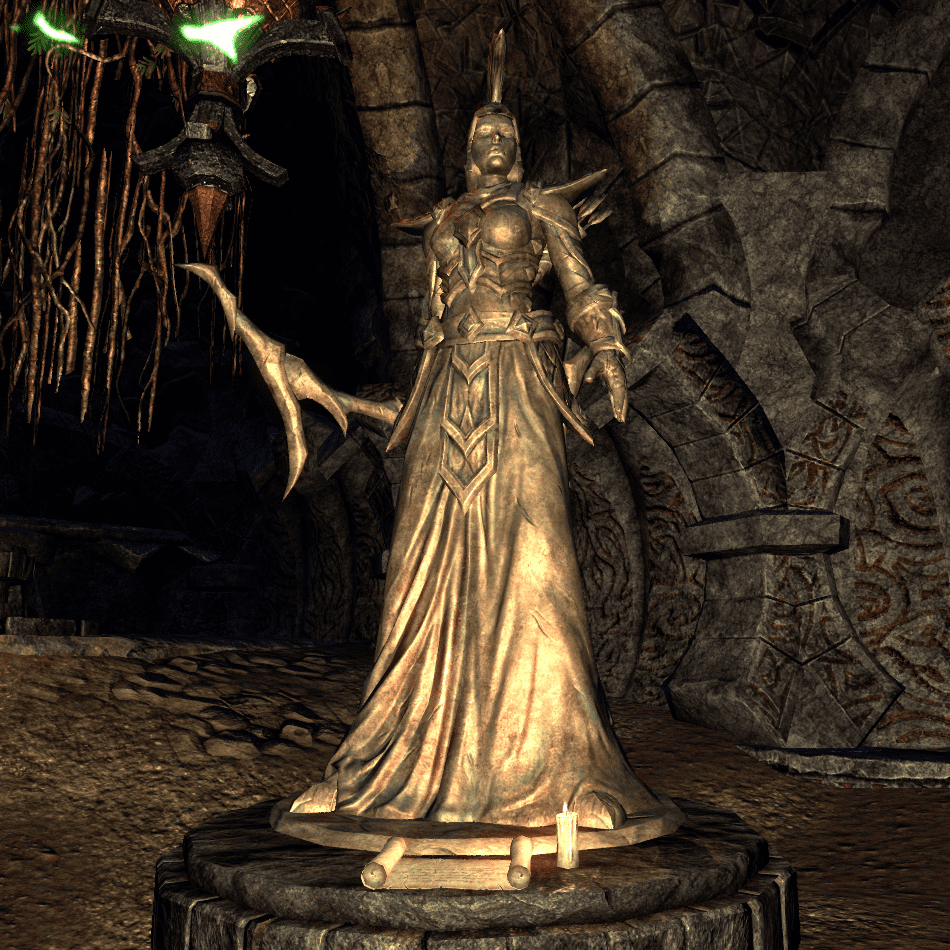 The Lava Queen, ESO The Lava Queen, ESO |
|
Whitebear defeated Lucius in his weakened state and founded the first organized gladiator clan, the Bear clan. Since its founding, other renowned gladiators began to form their own clans, and thus the tradition of competing in organized groups was born.[24] |
Ferian the Passive reigned as Champion for a very short time. It is said that he grew soft and complacent once he was crowned Champion. His lack of willingness to defend his crown led to the first Gladiator Uprising, when a prominent gladiator named Felhorn led his clan into the Arena to force Ferian's hand, resulting in his eventual defeat.[25] |
Felhorn claimed the Brimstone Crown in the bloody revolt known as the Gladiator Uprising. After a monumental fight with Ferian Darkstorm, the former Champion was cleaved in two by Felhorn's enchanted sword. Humbled by his near defeat, Felhorn disbanded his army and took his seat as Champion of the Blessed Crucible. He later erected great monuments to Malacath within the arena.[26] |
Sanarel the Great reigned as Champion for nearly two centuries. His command of shield and blade were unmatched and his victories were swift and merciless. It was said that he carried a magical shield enchanted by Trinimac himself. As his legend and his arrogance grew, favor with his patron deity waned, leading to his eventual defeat at the hands of the Lava Queen.[27] |
The Lava Queen was said to be the greatest Champion the Blessed Crucible has ever known. Reigning for nearly four centuries, all challengers who dared face her in the Arena were overwhelmed by her fiery magic, as if they were fighting a living volcano. It's said her mastery of the arena was so complete that the very ground shaped and molded itself to her will.[28] |
Durak gro-Batul[edit] |
|
|
A statue known as the King's Sepulcher was built in the town of Rivercrest during the Fourth Era. It pays homage to Durak gro-Batul, a figure of much respect in the region who served as the first Bloodfall King and was also the grandfather of the Bloodfall Queen Urzoga gra-Batul. The statue depicts Durak wielding two war-axes as a serpent is wrapped around the plinth.[29] |
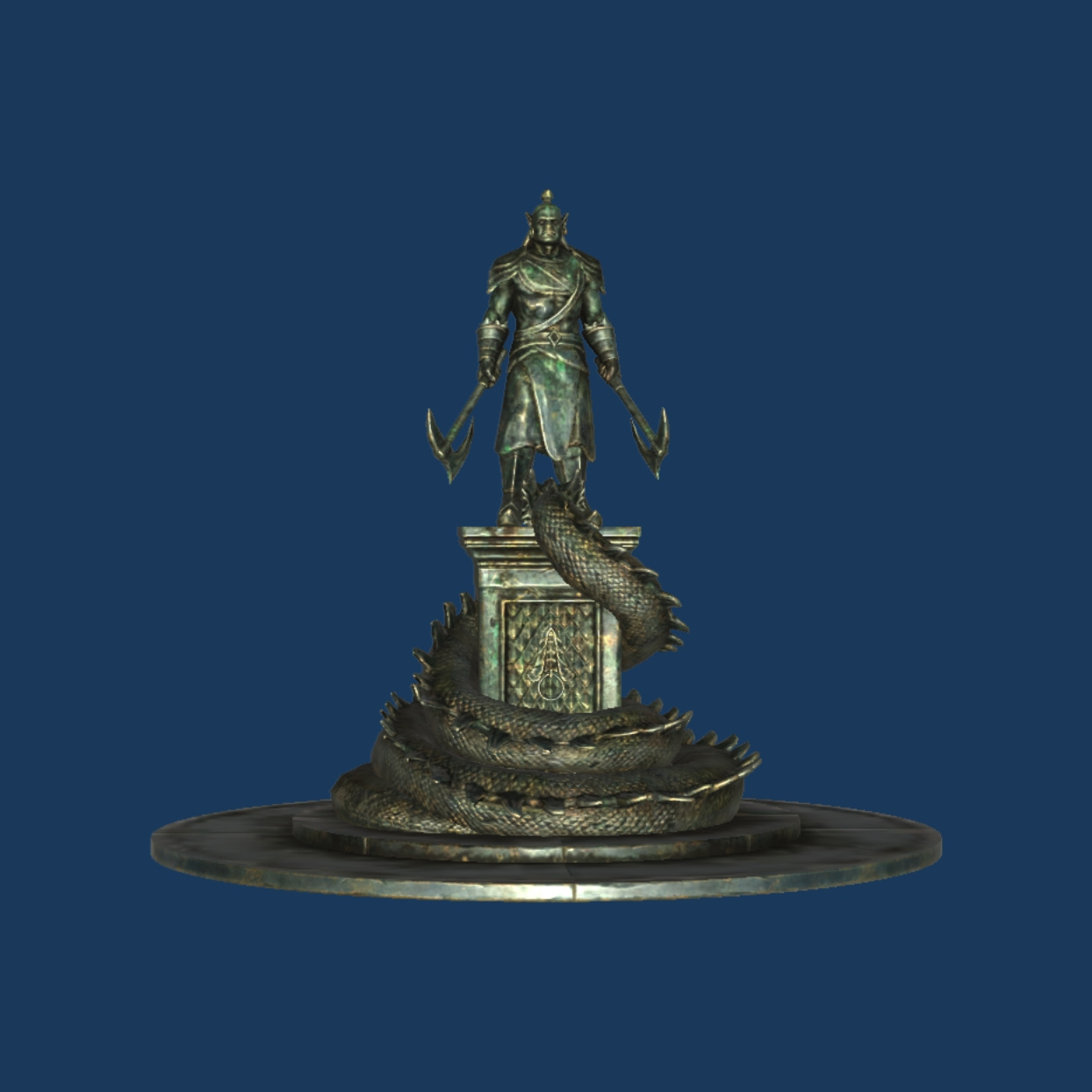 Blades Blades |
Durcorach[edit] |
|
|
Despite ruling as emperor, the only known artistic depiction of Durcorach is found in the athenaeum of Black Drake Villa, his grand retreat on the Gold Coast. The bas-relief depicts Durcorach conquests as he and his Reachmen army march on the Imperial City.[30] |
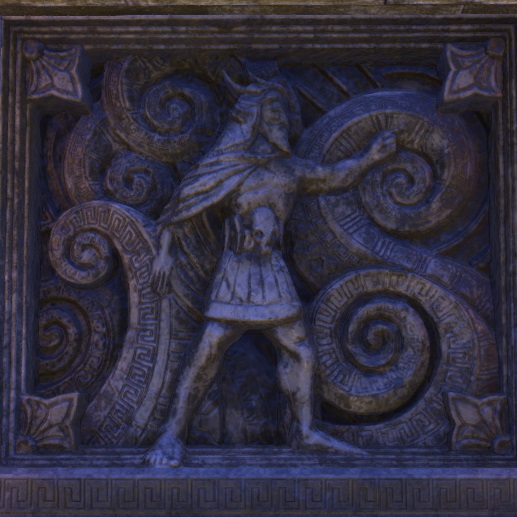 ESO ESO |
Ettiene Volusus[edit] |
|
|
Ettiene Volusus was one of the four greatest grandmasters of the Dragonguard in the late-First Era. She was the chronicler of their history and is remembered as being modest, honest, and astute. After her death, a statue of her was built in Wind Scour Temple alongside the other great grandmasters.[31][32] During the return of Kaalgrontiid, Sai Sahan briefly traveled to the temple during his quest to learn the old ways of dragon slaying. Ettiene's statue was discovered to be part of a mechanism that allowed Sai to reach the hidden Dragonguard archives, wherein he learned about the fabled Horn of Ja'darri.[33] |
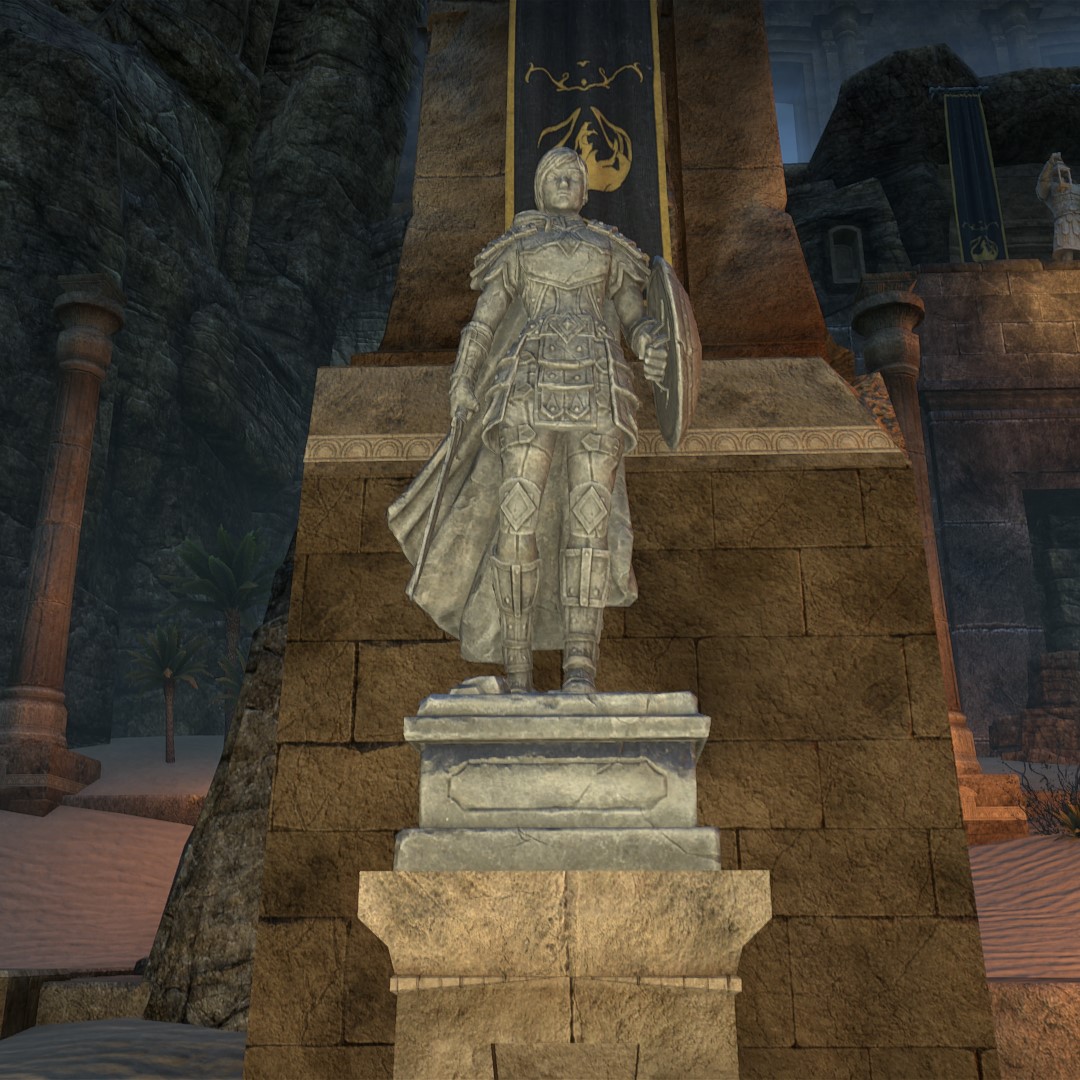 ESO ESO |
Frandar Hunding[edit] |
|
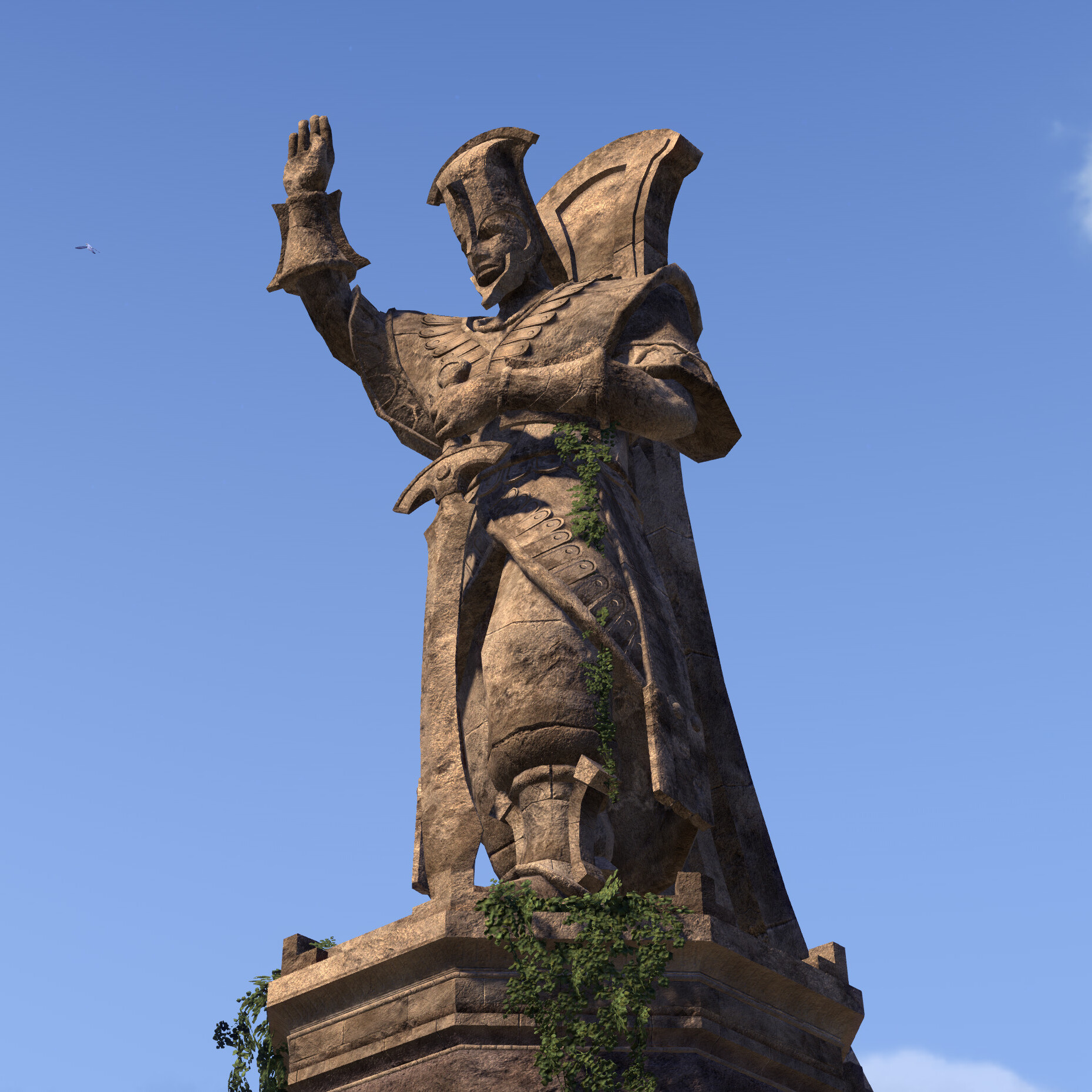 ESO ESO |
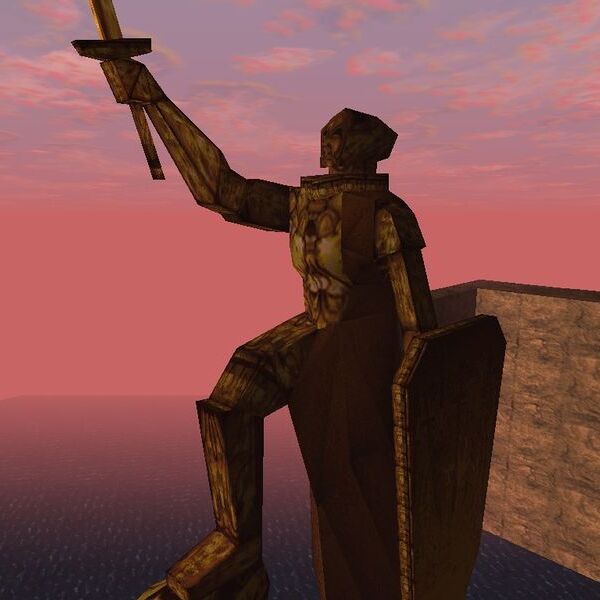 Redguard Redguard |
|---|---|
|
The Statue of Hunding is a monument found west of Stros M'Kai's harbor. It is dedicated to the legendary Yokudan hero, Frandar Hunding, who is said to have driven the goblins of Hammerfell back into the earth. The statue depicts Hunding armed with a sword, resting his foot on a goblin's head. According to local legends, the statue's presence keeps the goblins underground.[34] Inside the statue is a hidden room that was discovered by Cyrus in 2E 864. Here he found the Talisman of Hunding, which he used to open a crack in the wall in the Goblin Caverns.[35] |
|
Ghelin-Brol[edit] |
|
|
Ghelin-Brol was one of the four greatest grandmasters of the Dragonguard in the late-First Era. He is remembered as the first grandmaster of the order and was appointed by Reman I himself. After his death, a statue of him was built in Wind Scour Temple alongside the other great grandmasters.[36][32] During the return of Kaalgrontiid, Sai Sahan briefly traveled to the temple during his quest to learn the old ways of dragon slaying. Ghelin-Brol's statue was discovered to be part of a mechanism that allowed Sai to reach the hidden Dragonguard archives, wherein he learned about the fabled Horn of Ja'darri.[33] |
 ESO ESO |
Gray Fox[edit] |
|
|
The leader of the Thieves Guild, Mercer Frey, kept a small bust of the Gray Fox in Riftweald Manor in Riften. It depicts a figure wearing the infamous Gray Cowl of Nocturnal. The bust was stolen in the early-Fourth Era after Mercer Frey betrayed the guild, and later put on display in the thieves guildhall.[37] |
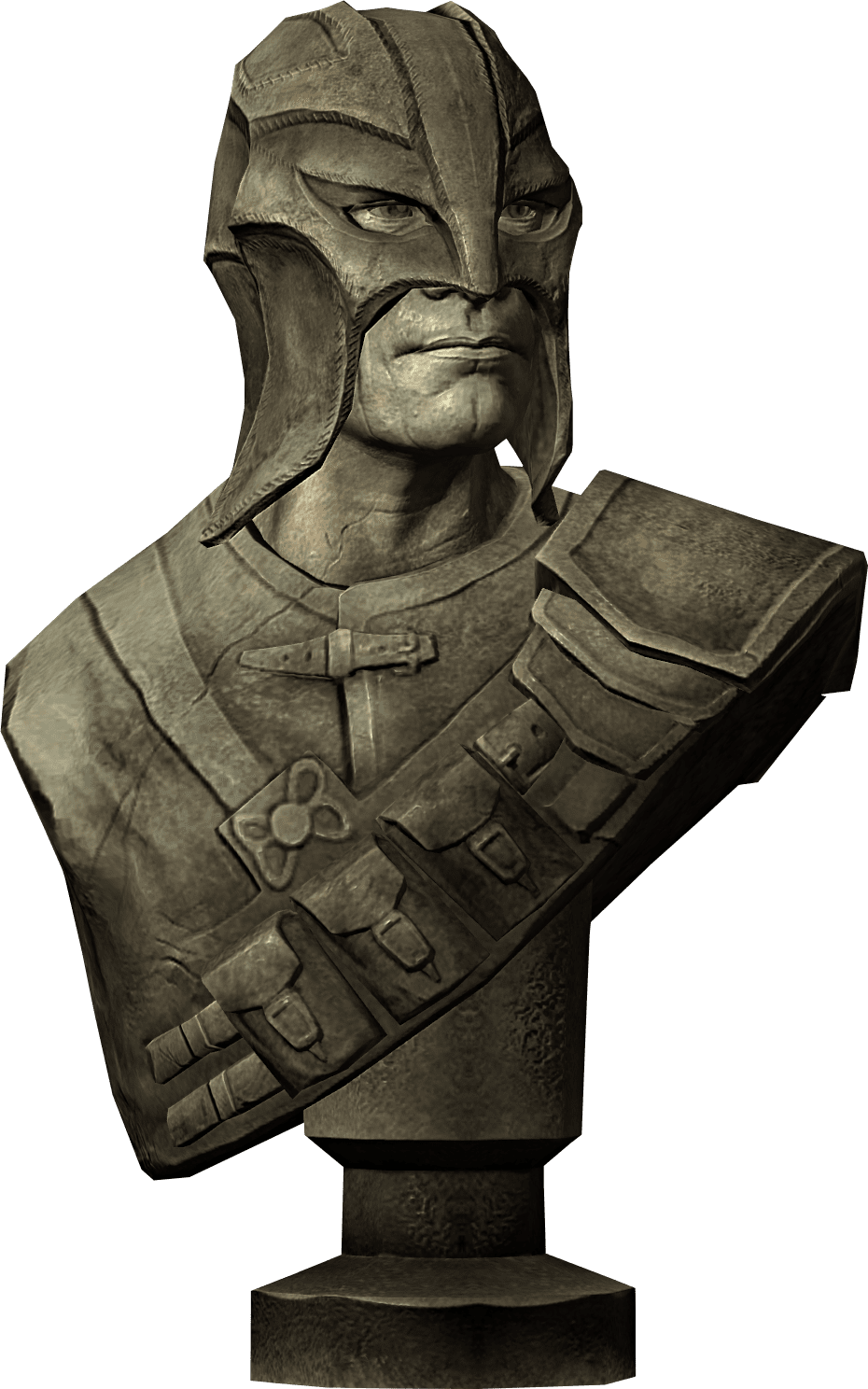 Skyrim Skyrim |
Hubalajad[edit] |
|
|
Prince Hubalajad, more commonly known as Prince Hew, was a Yokudan noble who colonized Hew's Bane during the First Era. He is believed to have commissioned a colossal idealized statue of himself, named "Hubalajad's Reflection", near the docks of Abah's Landing that depicts him holding a sword while a large Sep Adder is wrapped around his torso.[38][39] Some Second Era apologist historians however claim the statue does not represent Hubalajad and that this belief is erroneous.[40] |
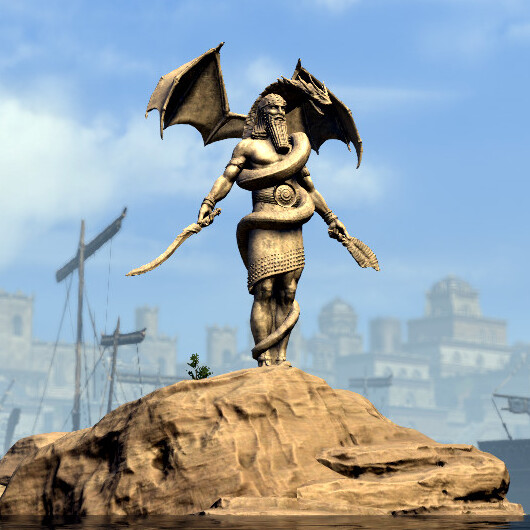 ESO ESO |
Ja'darri[edit] |
|
|
Ja'darri the Endless was an ancient Khajiiti hero who founded Pridehome and formed the Pride of Alkosh.[41][42] She bore the Mask of Alkosh, a relic capable of granting the bearer immense power when tapped into by a Dragon. She is best remembered as the one who succeeded in imprisoning the dragon Laatvulon in ancient times, however it cost Ja'darri her life.[43][44][45] She was buried in Halls of the Highmane in Elsweyr with the Mask of Alkosh, and a statue of her holding an hourglass and wearing the mask was erected in her burial chamber. A plaque with an inscription briefly gave details of her life.[41] Another statue of her was built in Pridehome that bore an inscription in honor of her sacrifice.[46] |
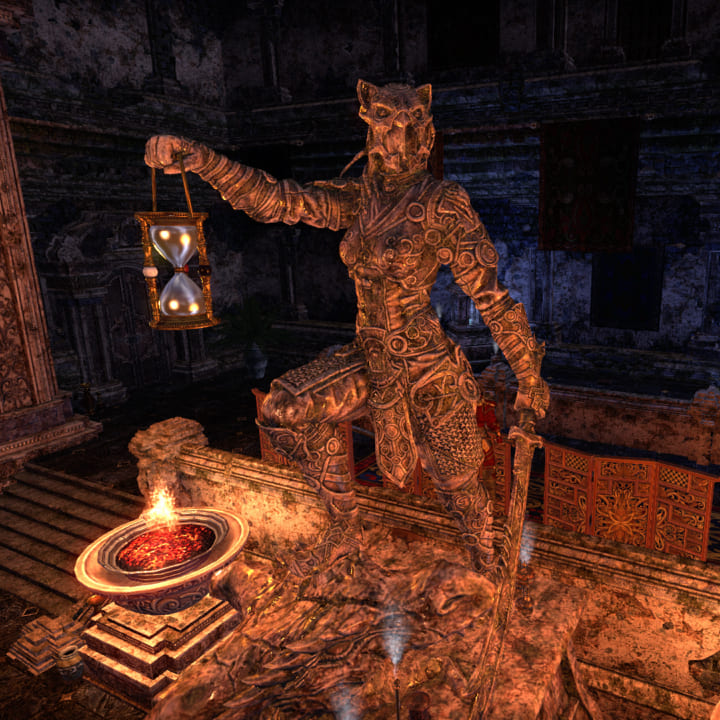 ESO ESO |
Jaiv-Yora[edit] |
|
|
Jaiv-Yora was one of the four greatest grandmasters of the Dragonguard in the late-First Era. She is remembered for overseeing the construction of the Alduin's Wall in Sky Haven Temple under the rule of Emperor Reman II. After Jaiv-Yora's death, a statue of her was built in Wind Scour Temple alongside the other great grandmasters.[47] During the return of Kaalgrontiid, Sai Sahan briefly traveled to the temple during his quest to learn the old ways of dragon slaying. Jaiv-Yora's statue was discovered to be part of a mechanism that allowed Sai to reach the hidden Dragonguard archives, wherein he learned about the fabled Horn of Ja'darri.[33] |
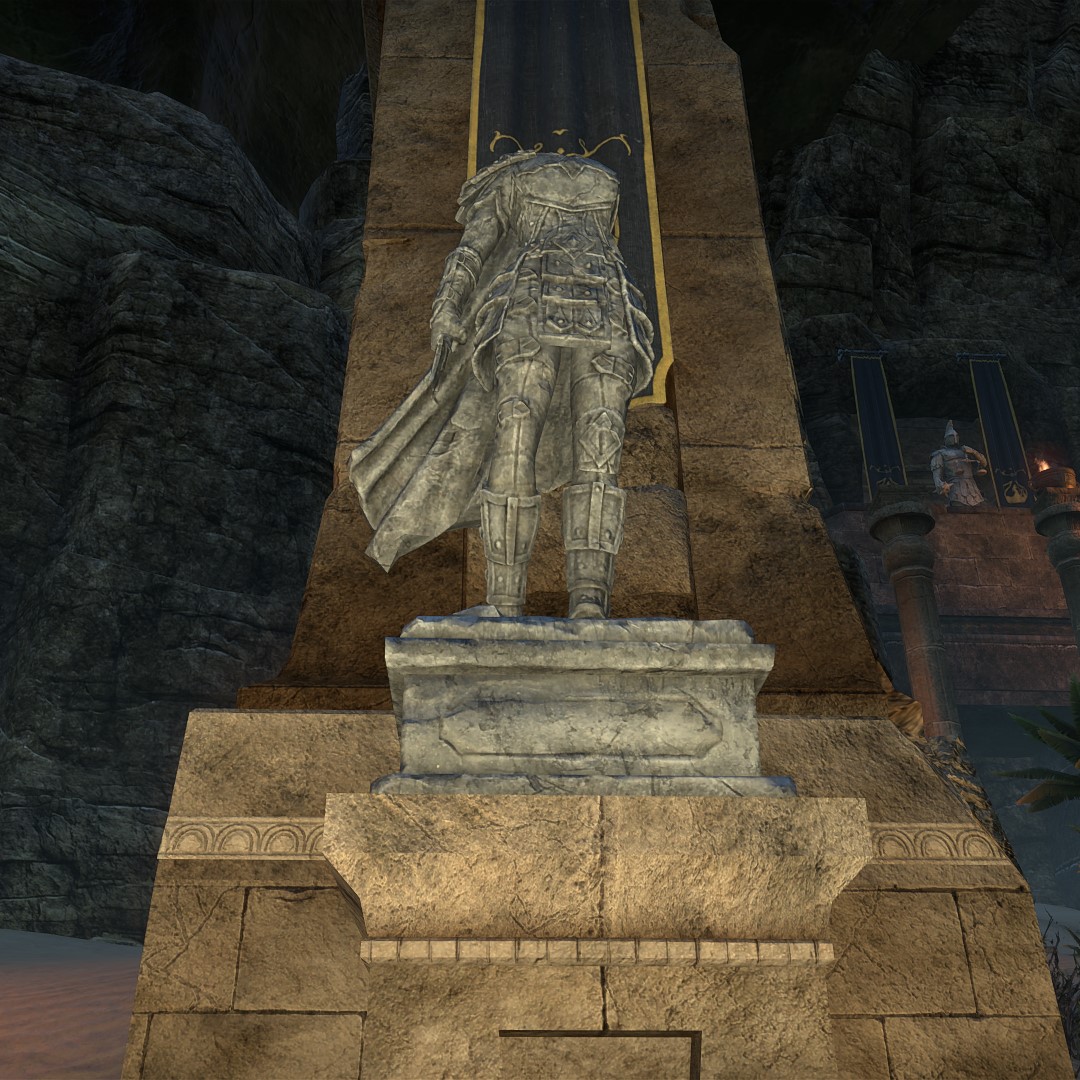 ESO ESO |
Katariah[edit] |
|||
|
A golden figurehead bearing the likeness of Empress Katariah graced the eponymously named flagship of Emperor Titus Mede II during the early-Fourth Era.[48] Katariah was proclaimed Empress upon the death of her husband in 3E 153, and her almost fifty-year reign is remembered as a happy one.[49] |
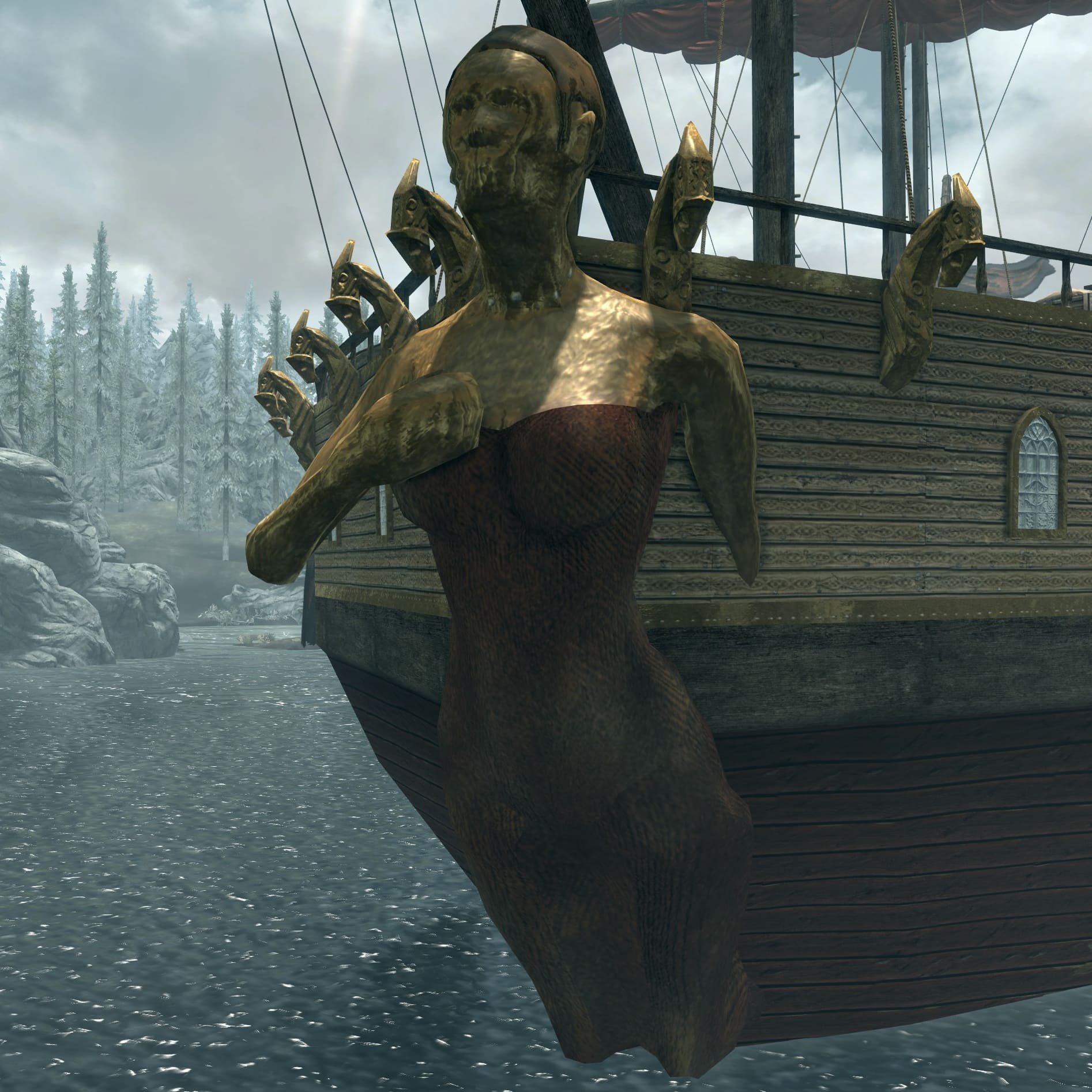 Skyrim Skyrim |
||
Khunzar-ri[edit] |
|||
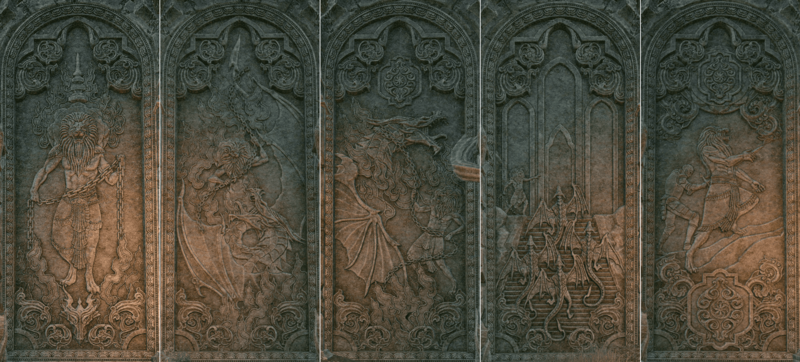 ESO ESO |
|||
|---|---|---|---|
|
In the Halls of Colossus in Elsweyr, a series of bas reliefs depict the legendary hero Khunzar-ri and his epic battle with Kaalgrontiid and his rage of dragons during the Merethic Era. The reliefs then shows the dragon being imprisoned in the Halls of Colossus.[50][51][52] The last panel depicts Khunzar-ri's betrayal at the hands of Cadwell, who sought the power of Jode's Core.[53] |
|||
Martinne Guimard[edit] |
|
|
A statue of Duchess Martinne of the Guimard family was built on High Isle at some point before the mid-Second Era. She is best remembered as the leader of a consortium of coin-barons that purchased the Systres archipelago from the Colovian kings during the late-First Era. She dubbed the largest island "High Isle," in honor of High Rock, the Bretons' ancestral homeland.[54] |
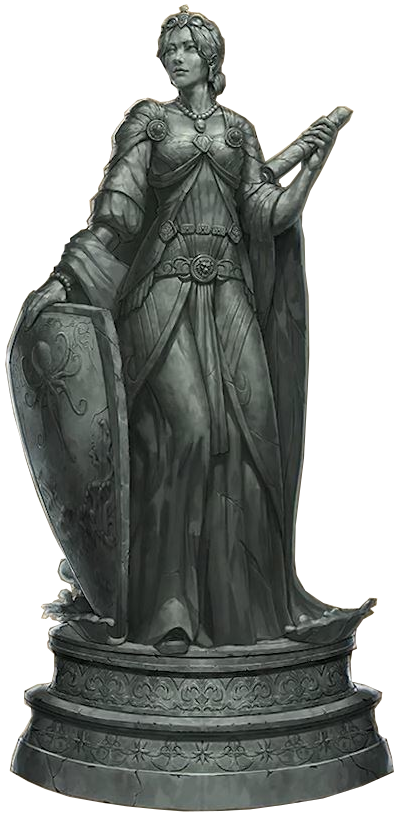 ESO ESO |
Morihaus[edit] |
|
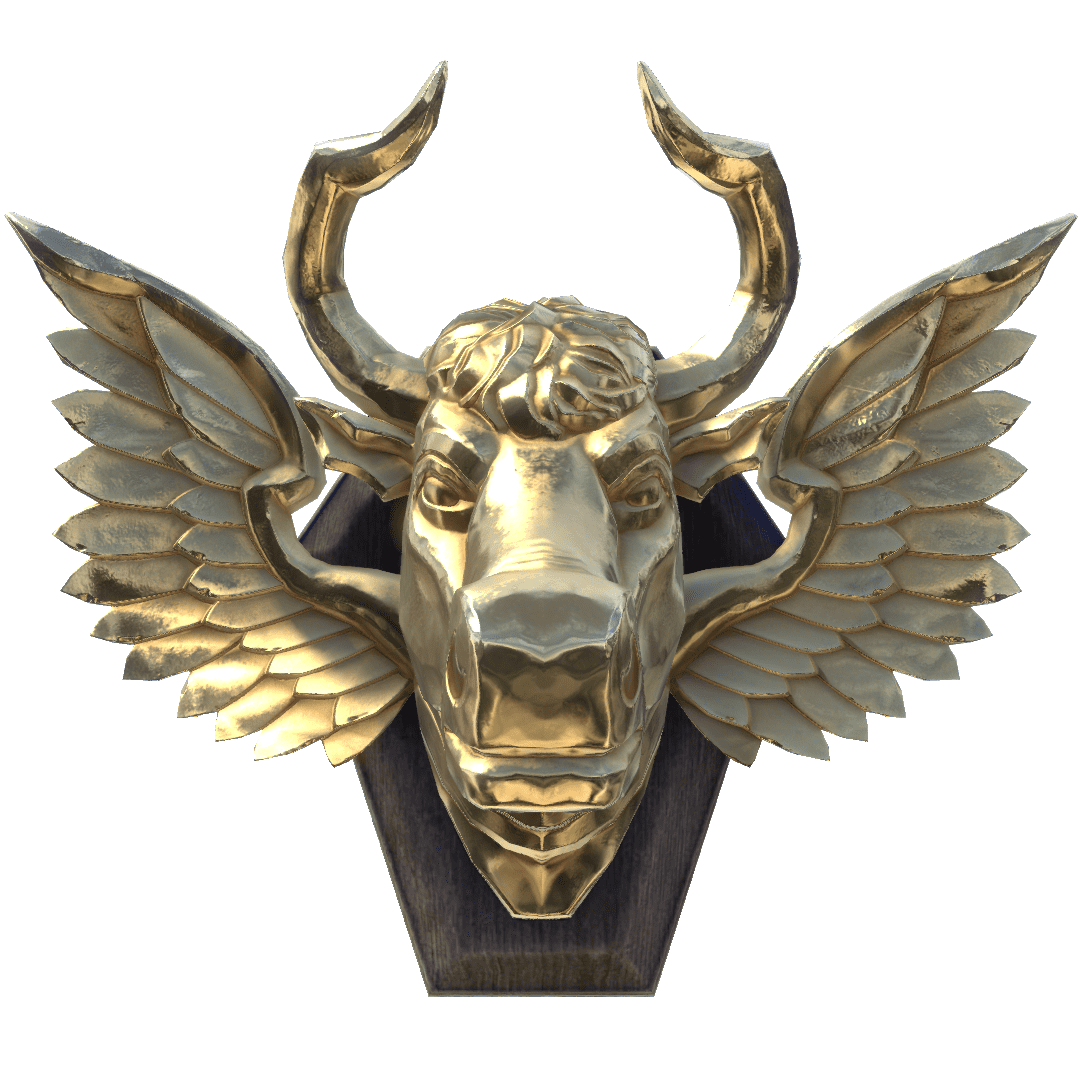 ESO ESO |
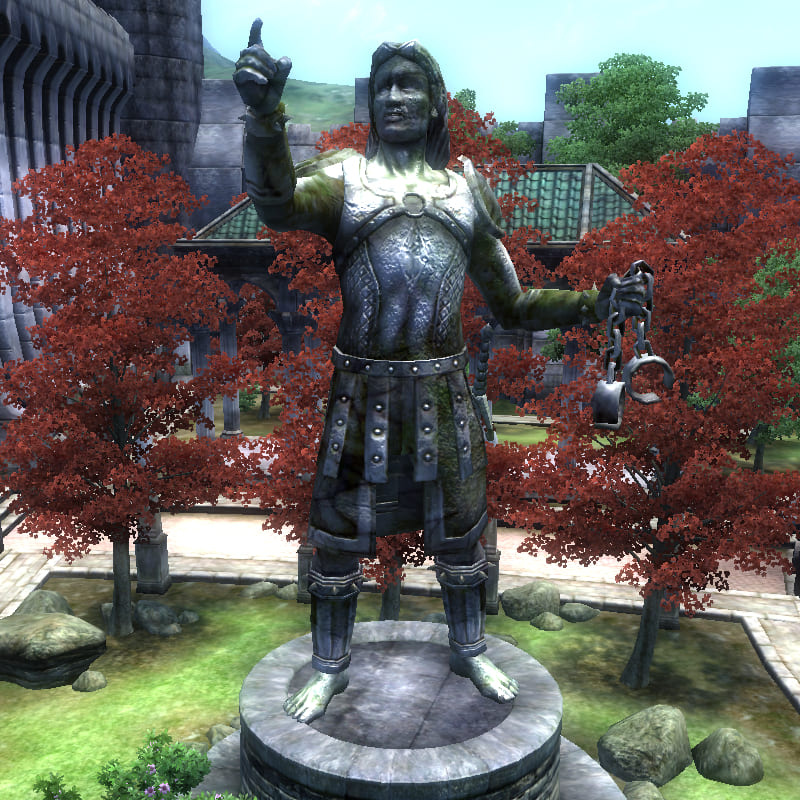 Oblivion Oblivion |
|---|---|
|
Golden statuettes and a bust of Morihaus was uncovered in the mid-Second Era by the Antiquarian Circle in Cyrodiil.[55][56] Although numerous sources describe Morihaus as a winged bull, be it a bull-man,[57] man-bull,[58] or the Bull of Kyne,[59] there was heated debate in scholarly circles during this time arguing what Morihaus actually looked like, and if depictions of him as literally bull-like were accurate or specious. Some argued that the winged bust was a symbolic representation of the subject, given the vacant, bovine expression bore no heroic personality and the wings were far too small. Others claimed that the existence of minotaurs was proof enough that chimeric creatures existed, and that a demigod exhibiting those traits was well within the realm of possibility.[55] This dispute has roots going back to the early years of the Alessian Order where horned depictions of Morihaus' son, Emperor Belharza the Man-Bull, were considered heretical as early as the 1E 1300s. Some scholars explain this shift by suggesting the Alessian Doctrines were applied to any non-human races xenophobic Alessians felt like persecuting. One controversial interpretation of an ancient tablet fragment called the Belharza Stone goes as far as asserting that the precursors of the Order may have murdered Belharza, and violently purged minotaurs from the Empire.[60] Conversely, Alessian vessels containing sacramental oil bore etchings of horns, adding to the confusion and leading some scholars to speculate this was how early Alessian priests honored Morihaus and Belharza. Similarly, Nibenese depictions of Morihaus and Belharza, albeit rare, were said to bear horns.[61] By the mid-Second Era, claims that minotaurs were descendants of Alessia and her consort Morihaus, were seen as lightly heretical and absurd among some scholars.[57] |
In the Third Era, a statue of "Pit Fighter" Morihaus was seen in the Arena District of the Imperial City but, unlike the previous depiction, he was fully human, dressed in gladiatorial attire and holding a set of shackles.[3][62]:344[nb 1] |
Morkuldin Trio[edit] |
||
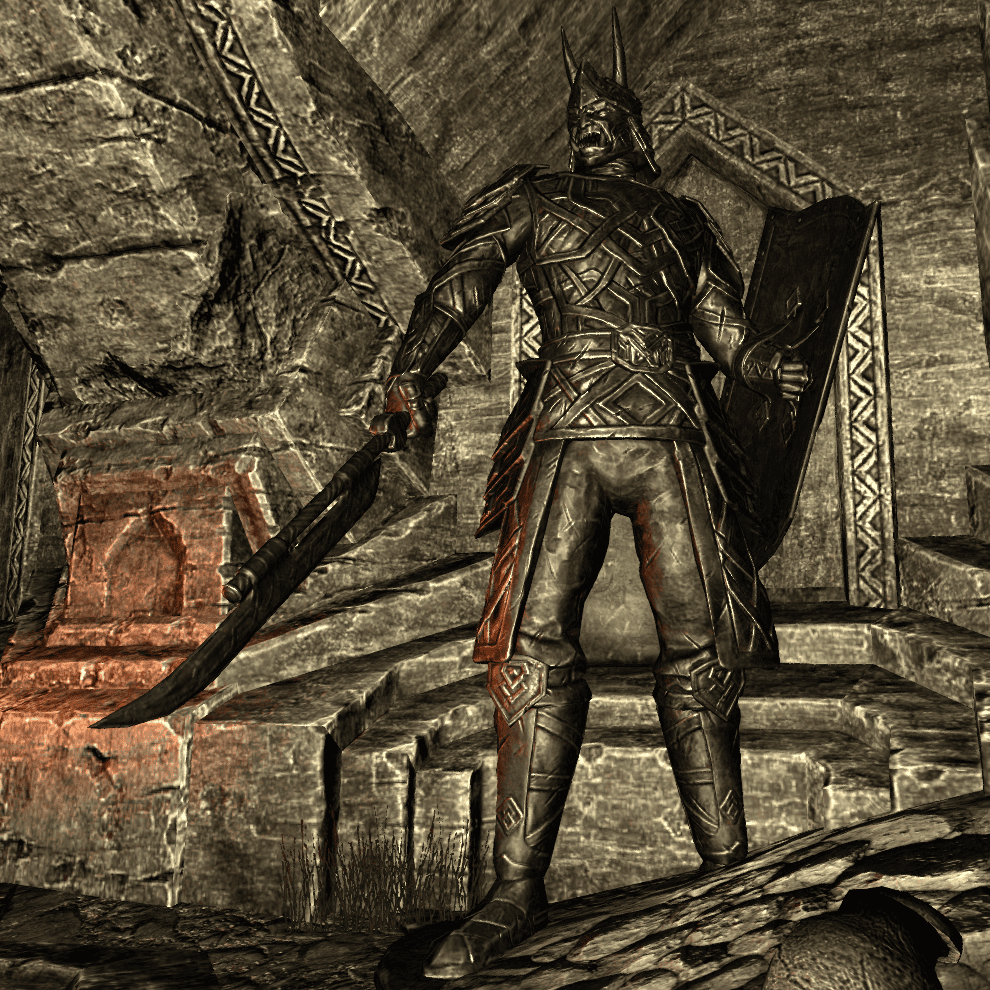 Baloth Bloodtusk, ESO Baloth Bloodtusk, ESO |
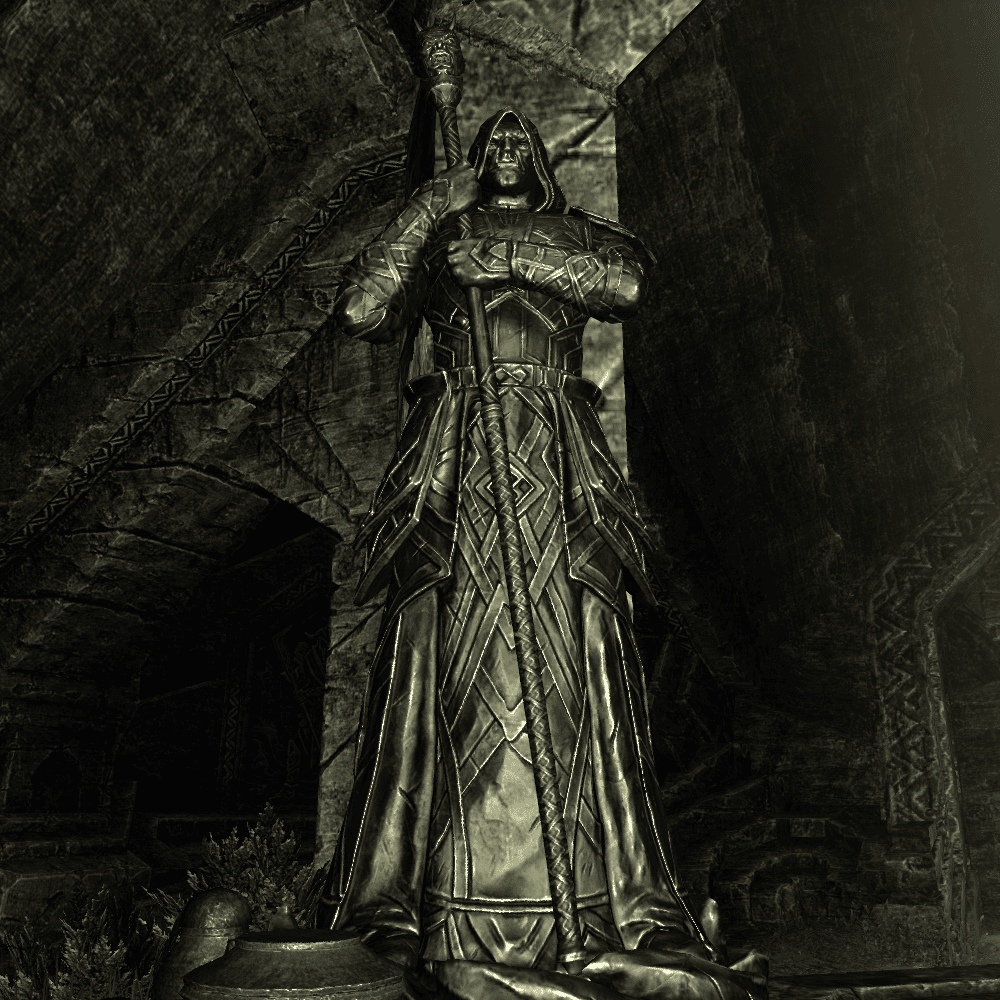 Mazghar Many-Tongues, ESO Mazghar Many-Tongues, ESO |
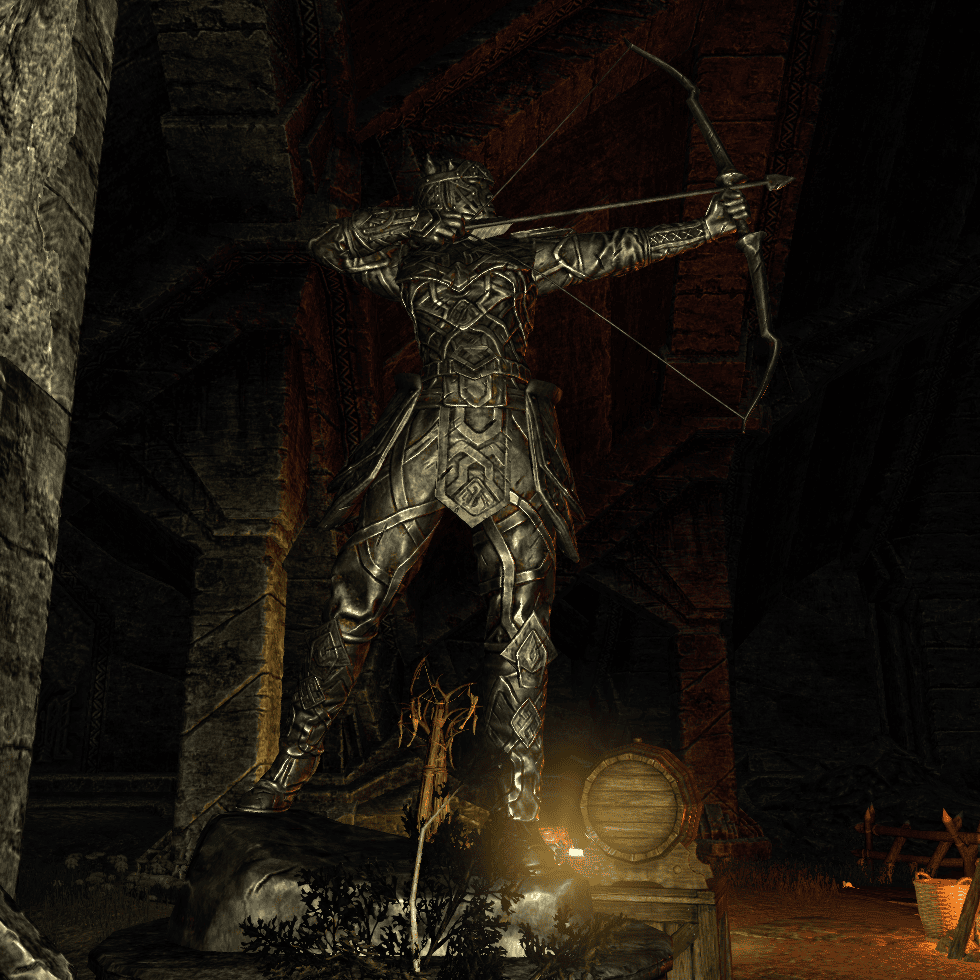 Lakora of the Hunt, ESO Lakora of the Hunt, ESO |
|---|---|---|
|
Morkuldin in Wrothgar was the ancestral stronghold of Morkul Clan. Old Orcish poems claim it was founded by a heroic trio, Baloth Bloodtusk, Mazghar Many-Tongues and Lakora of the Hunt, who "rebuffed winter's grasp" and "found haven beneath."[63] Large statues were erected of the three heroes deep in Morkuldin, which also served as a locking mechanism for Morkuldin's great blood-forge.[64][65][66] Later Orcish poems tell that Morkuldin was "buried in ice, and stone-marked thrice", which alludes to the ancient stronghold falling to the elements and abandoned.[63] |
||
Nemfarion[edit] |
|
|
A statue of Kinlord Nemfarion could be found in the sunken ruins of Corgrad, the city he founded and once ruled on Summerset Isle. During the Thrassian Plague circa 1E 2200, he drowned the city in an effort to stop the disease from spreading, then used blood sacrifices from the city's survivors to prolong his and his family's lives.[67][68] |
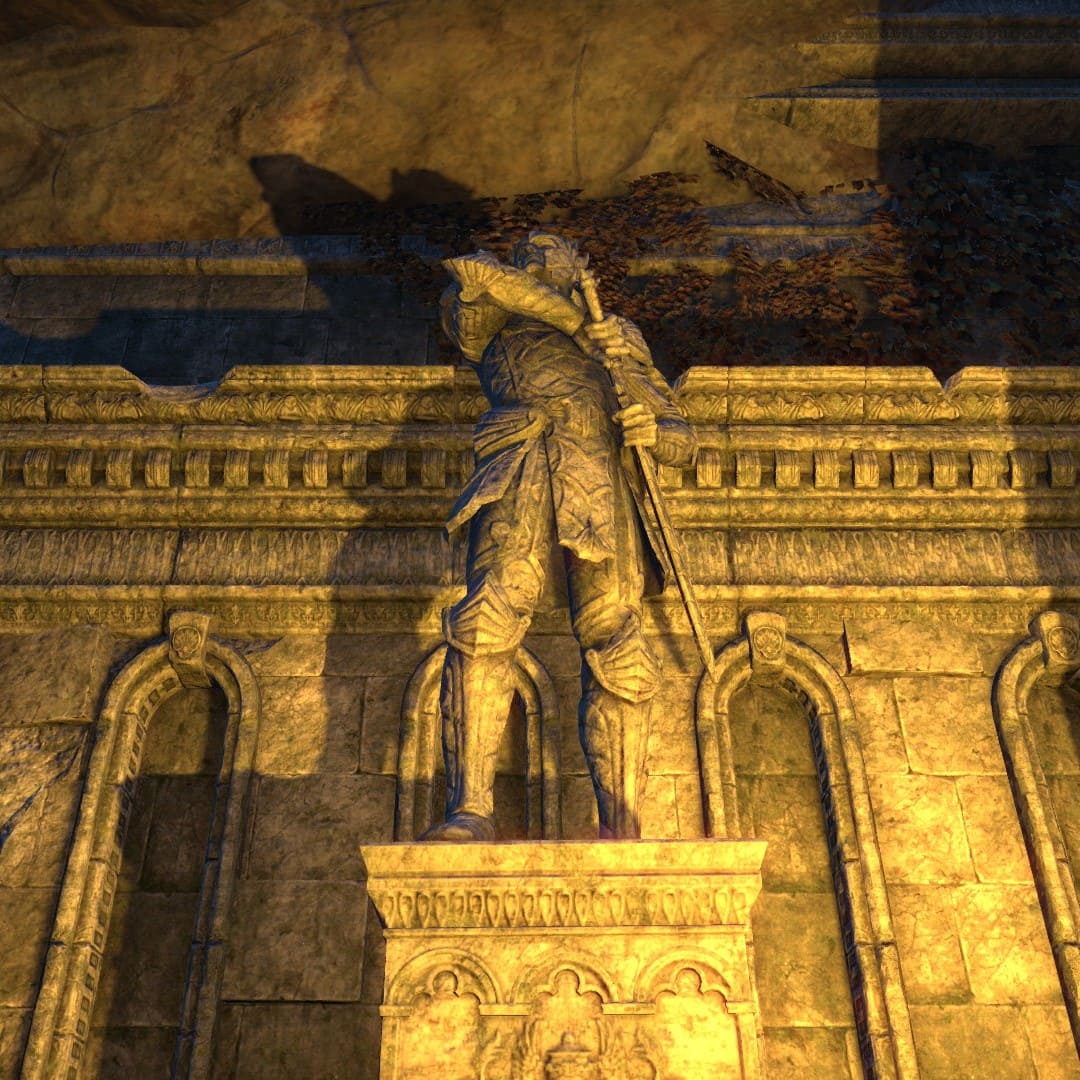 ESO ESO |
Order of the Hour[edit]The first reformation of the Order of the Hour in 2E 432 began with four founders, whose statues were built in Knightsgrave in Cyrodiil.[69][70][nb 2] |
|||
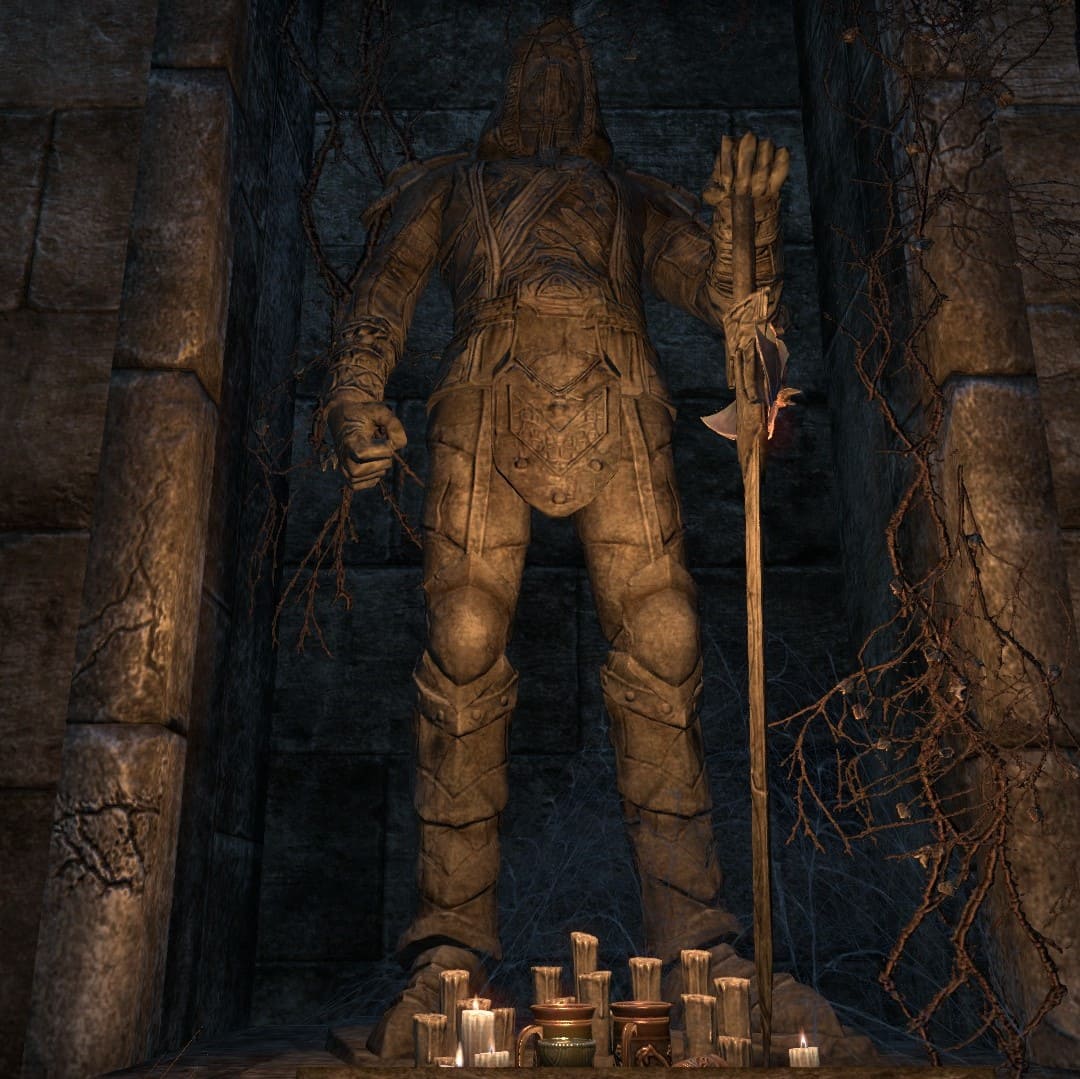 Cavor Merula, ESO Cavor Merula, ESO |
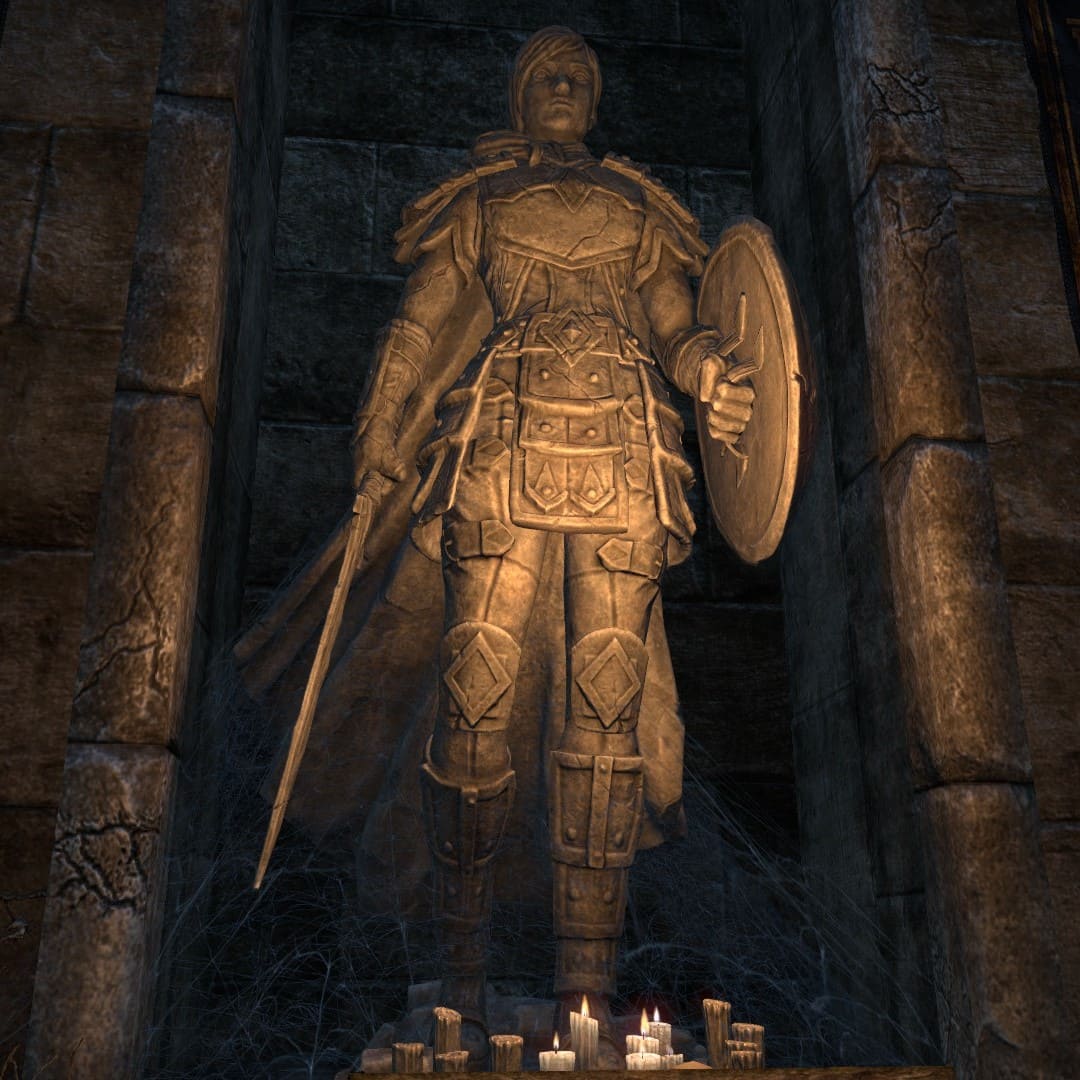 Justia Desticus, ESO Justia Desticus, ESO |
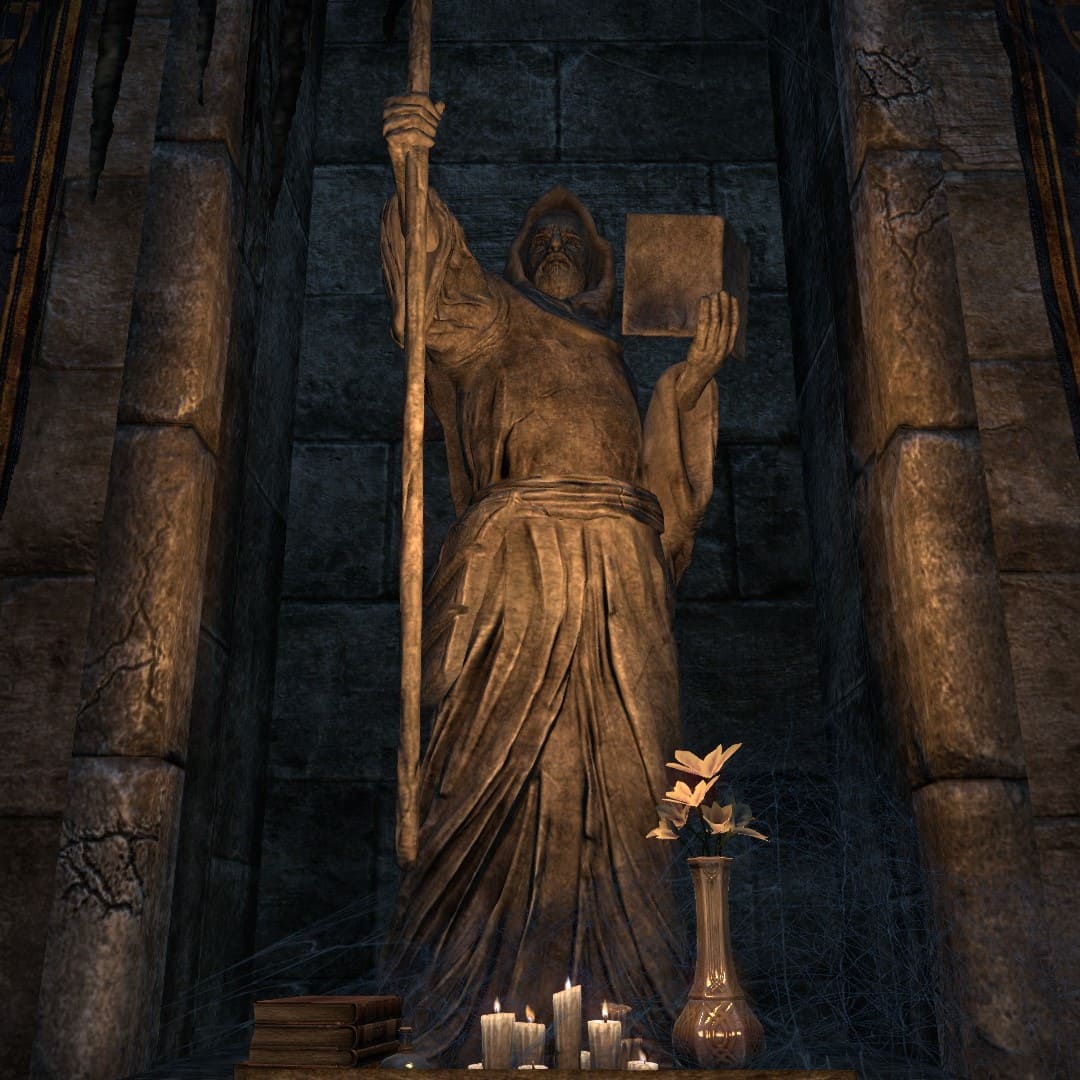 Rusio Olo, ESO Rusio Olo, ESO |
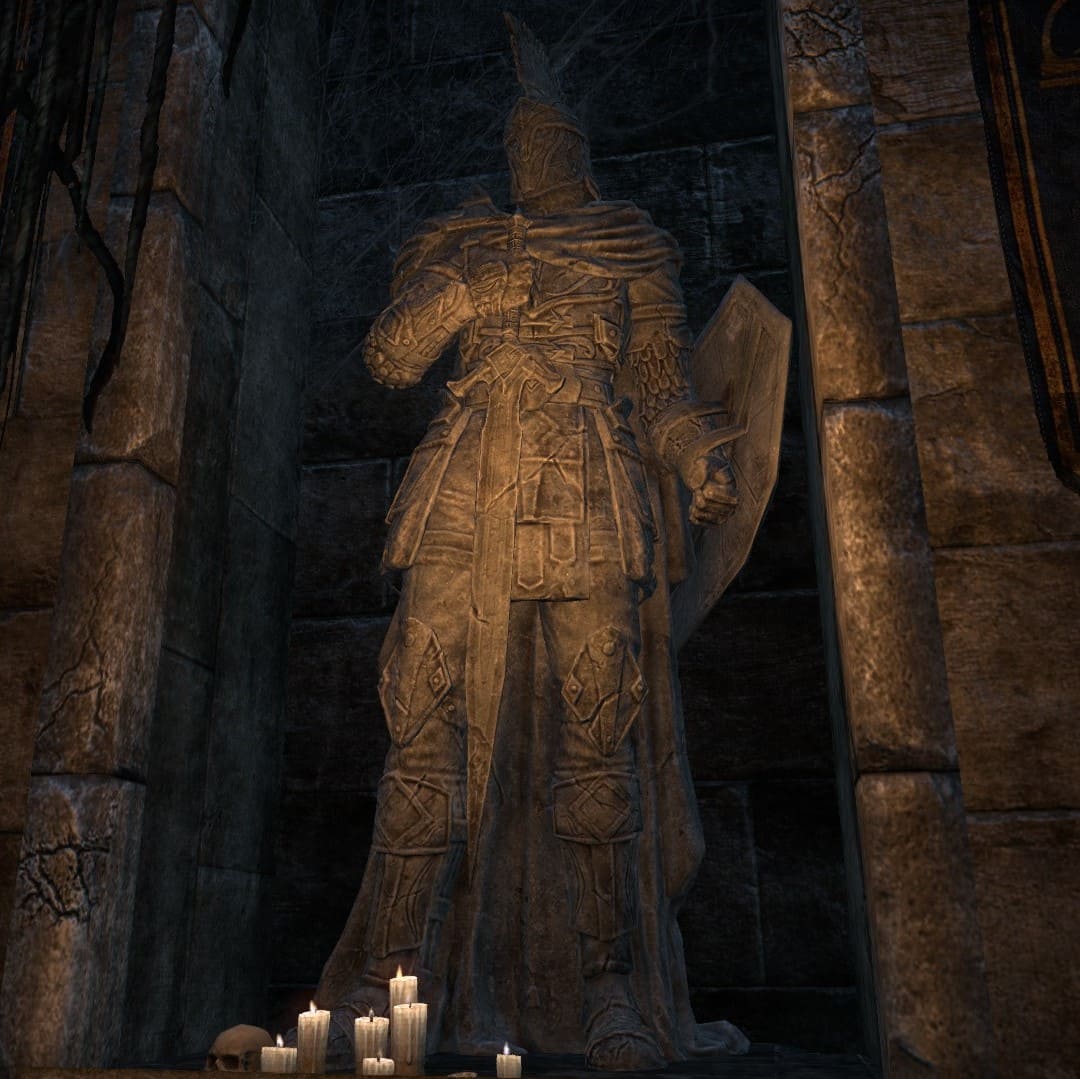 Amminus Entius, ESO Amminus Entius, ESO |
|---|---|---|---|
| Cavor Merula was a warrior-priest who formed the order from Kvatch in response to the fall of the Second Empire, fearing for the safety of the Akatosh Chantry and its many historic and religious memorabilia. He gathered a group of warrior-priests to defend the cathedral, and thus the Order of the Hour was reborn.[71] | Justia Desticus was the original First Sword of the Order of the Hour and stood by Cavor's side and devised the Rigors of Akatosh, eight traits to which all members must aspire. She is considered the second in devotion in Akatosh's eyes.[72] | The third pillar of the Order of the Hour's original complement of warrior-priests, Rusio Olo, was instrumental in ending the Order of the Black Worm's infestation of Kvatch in 2E 437. He dispatched eight cultists and their leader singlehandedly.[73] | Amminus Entius was known as the fourth pillar of the Hour and was Cavor's oldest friend and the Order's first quartermaster. He established the infrastructure for ensuring that Akatosh's knights were the best-fed, best-equipped, and best-trained force in Kvatch.[74] |
Pelagius I or IV[edit] |
|
|
A statue described confusingly as "Pelagius IV: Son of Tiber Septim"[75]:347 was built in the Market District of the Imperial City at some point in the Third Era. Which ruler the statue depicts is unclear because Pelagius I is described as Tiber's eldest son in some sources,[76] and his grandson in others.[77] Further, Pelagius IV was born around 300 years after Tiber Septim.[78] |
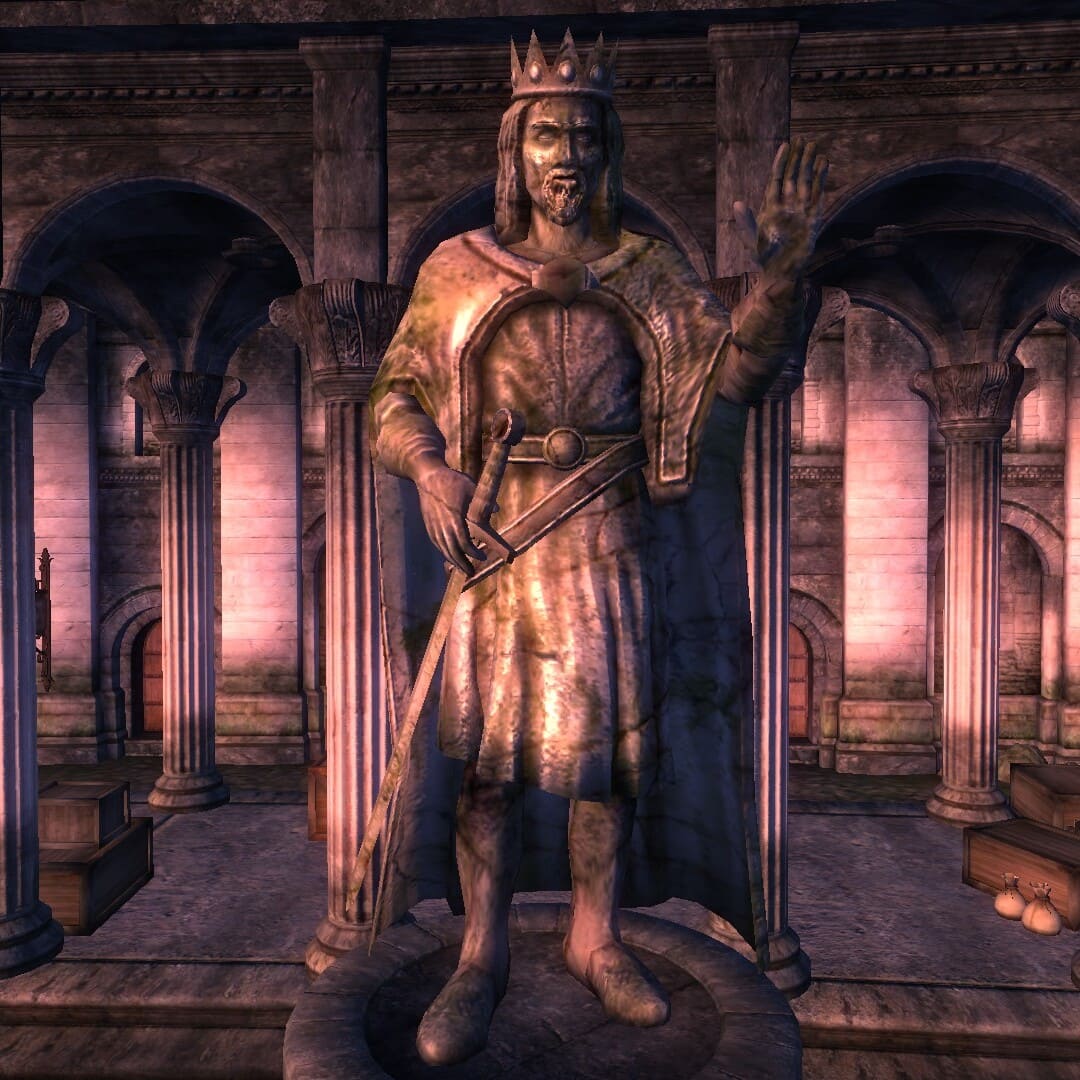 Oblivion Oblivion |
Reman[edit] |
|
|
A large sculpture of Reman's head could be found in Sky Haven Temple.[79] It was built around the same time as Alduin's Wall in 1E 2812 and was connected to a magical Blood Seal that served as the locking mechanism to the temple's entrance.[80] |
 Skyrim Skyrim |
Rislav the Righteous[edit] |
|
|
A statue of King Rislav Larich, known also as Rislav the Righteous, could be found in Skingrad during the late-Third Era. He is depicted on his horse with his hawk perched upon his hand.[81]:365 He is noted in history after he liberated Skingrad from under the rule of Emperor Gorieus, after which he was crowned king.[82] |
 Oblivion Oblivion |
Sai Sahan[edit] |
|
|
A statue of Sai Sahan was built in Leyawiin during the mid-Second Era to honor of the sword-master after he freed the city from Reachmen occupation. According to some, he emerged victorious, returning to the rebellion base at Bruma weeks later with eighty-six enemy scalps. Accounts of the battle vary: some believe he single-handedly liberated Leyawiin in one battle, while others say he murdered the guards for days until the Reachmen eventually left the settlement with their mercenaries.[83] |
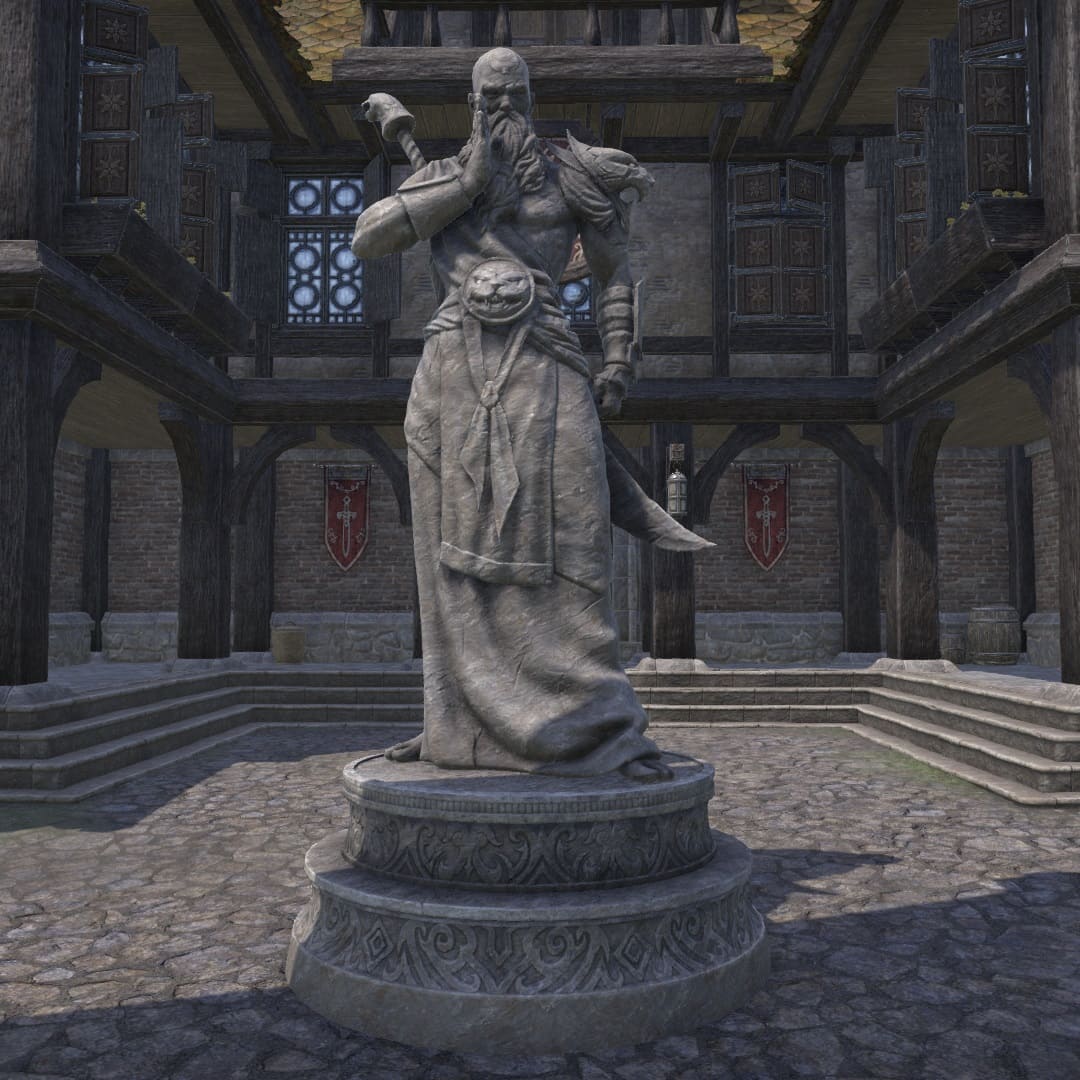 ESO ESO |
Savior of Bruma[edit] |
|
|
A statue of the Savior of Bruma, also known as the Hero of Kvatch, was erected in the city of Bruma during the Oblivion Crisis in the late-Third Era. After Mehrunes Dagon opened a Great Oblivion Gate outside the city walls, the hero ventured into the Deadlands and closed it before a Daedric siege engine could destroy Bruma and Cloud Ruler Temple. Bruma was saved from destruction and the hero was named the "Savior of Bruma". A statue was built in their honor and many songs and stories were told of this battle thereafter.[84][85][nb 3] |
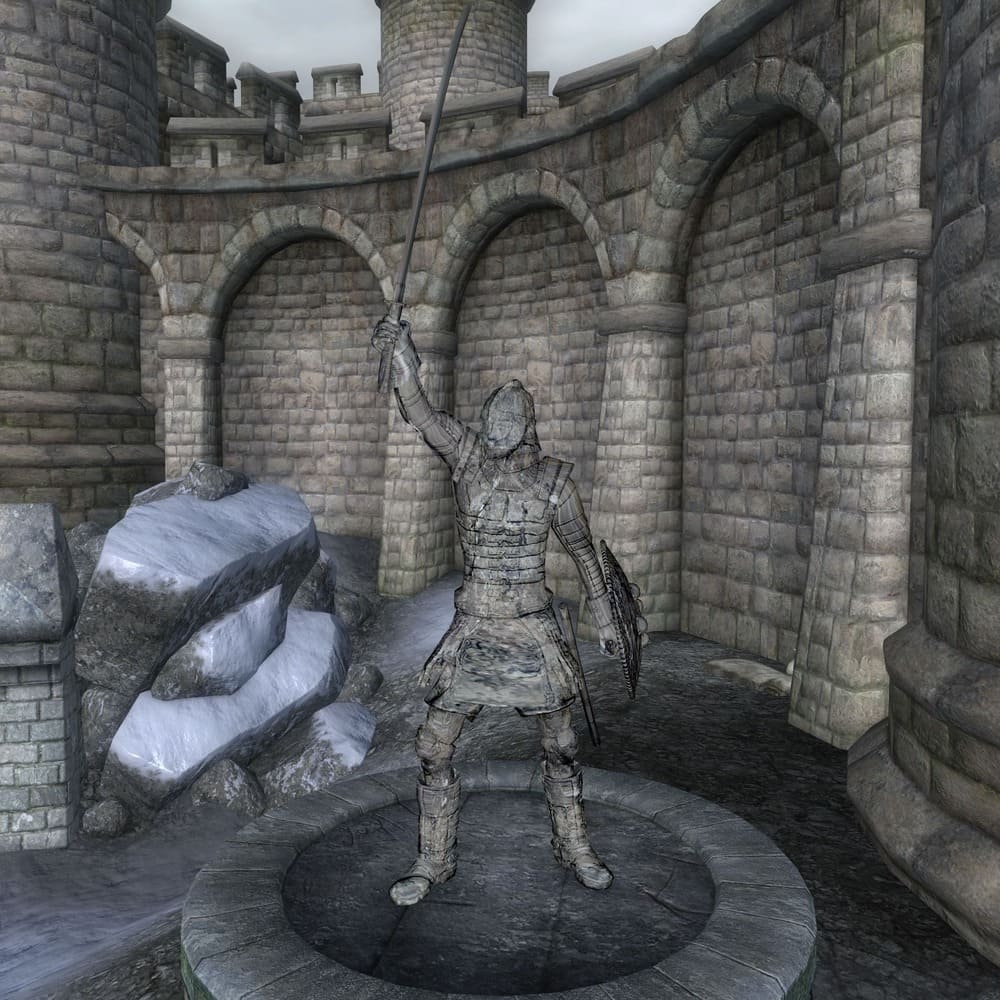 Oblivion Oblivion |
Shalidor[edit] |
|
|
A large statue of Arch Mage Shalidor could be found in the courtyard of the College of Winterhold.[86] According to legend, Shalidor built the city of Winterhold with a whispered spell.[87] |
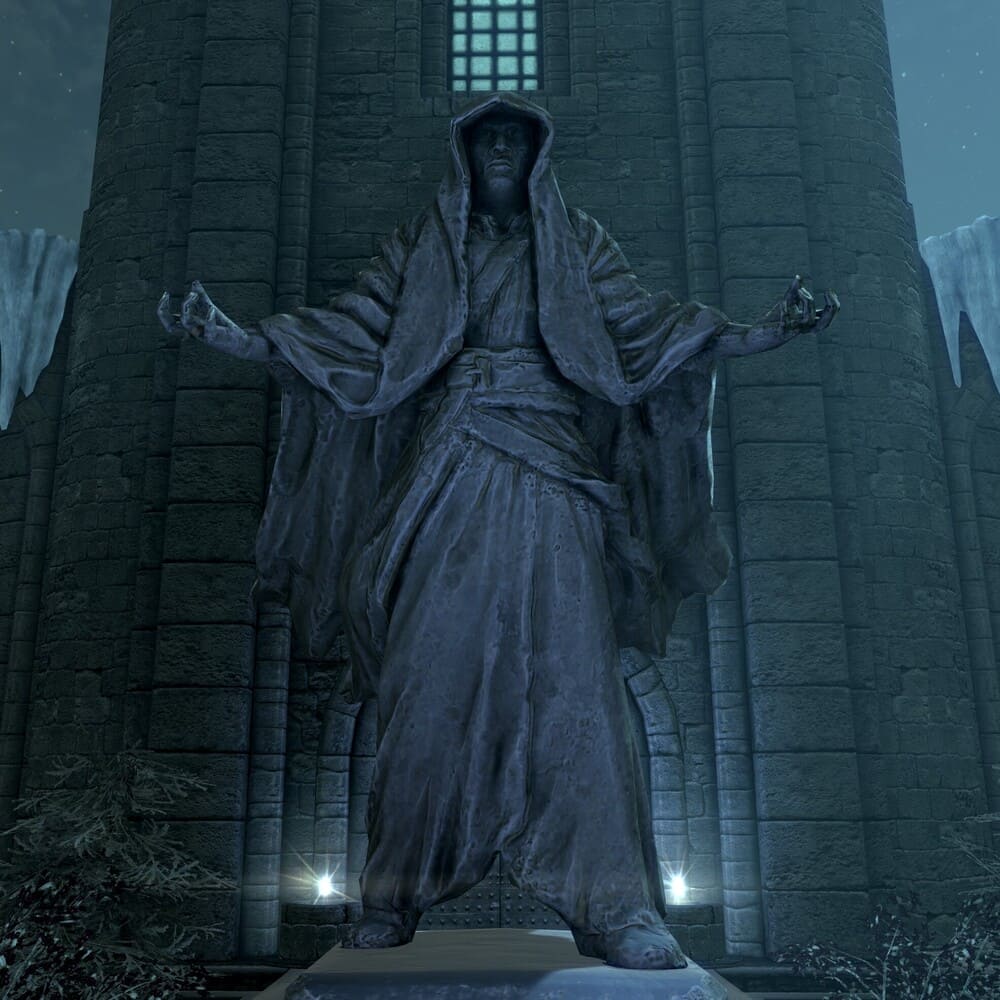 Skyrim Skyrim |
Thassad II[edit] |
|
|
The headless statue of High King Thassad II could be found northwest of Port Hunding on Stros M'Kai. Upon his death, the city of Sentinel was taken by the Forebears, despite Thassad's truce with Baron Volag. Thassad's son, Prince A'tor, attempted to recapture the city but was eventually defeated by combined forces of the Forebears and Tiber Septim's fleet at the Battle of Hunding Bay.[88][89][90] |
 Redguard Redguard |
Topal the Pilot[edit] |
|
|
A statue of Topal the Pilot was erected in the city of Leyawiin at some point after the mid-Second Era. He is depicted holding a map.[91]:363 He was the first known Aldmer to explore Tamriel, charting its sea lanes in the Merethic Era on his ship the Niben, after which the Niben River was named.[92] By the late-Third Era he was recognized as the patron saint of Leyawiin.[93] |
 Oblivion Oblivion |
Uriel Septim III[edit] |
|
| A statue of Uriel Septim III was built in the Market District of the Imperial City at some point in the Third Era. It stood as a monument to Uriel III's victory in the War of the Red Diamond.[94]:347 | 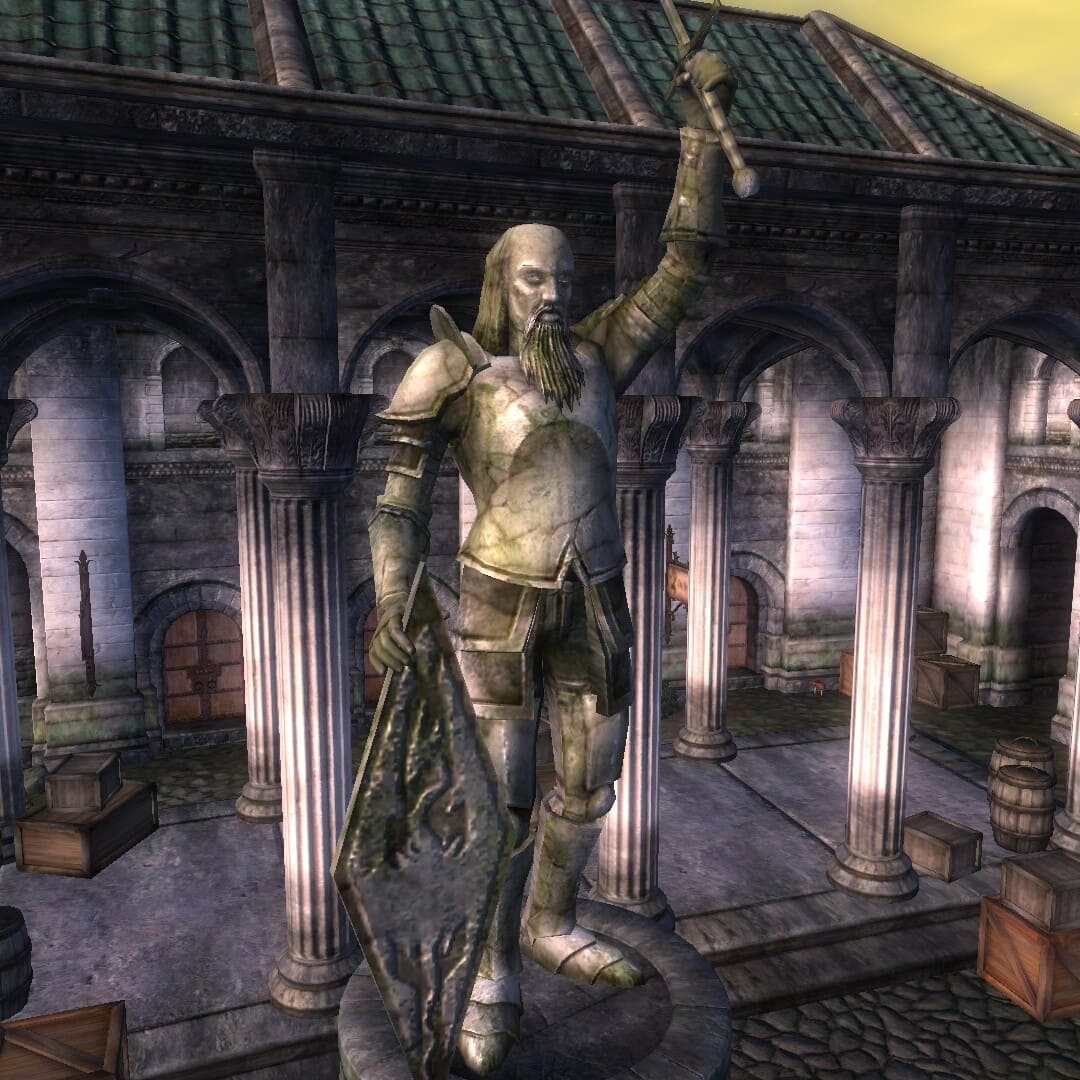 Oblivion Oblivion |
Valentis[edit] |
|
|
A marble statue of the Ayleid ruler named King Valentis riding a Gryphon was built above an ancient and mysterious crypt in Cyrodiil. Known as the Founder's Statue or Elder Statue, the enchanted statue's origins and significance was lost to time for centuries until the early-Fourth Era. During the First Era when the Ayleids ruled Cyrodiil, a powerful and feared sorcerer-king known as Celemaril Light-Bringer sought to conquer Tamriel with an undead army. Celemaril's own brother, Valentis, led other Ayleid kings in a rebellion against Celemaril. By performing a ritual incantation using varla stones and an Elder Scroll, Valentis sealed his immortal brother within a crypt beneath a statue bearing his likeness. He then placed a warding enchantment upon the statue to ensure Celemaril's spirit remained sealed in the crypt.[95][96][97] Valentis ruled as king and went to great length to have Celemaril's name and conquest erased from historical records. He also founded the town of Rivercrest at the site of the statue that sealed Celemaril.[98][97] Centuries passed and most records of the brother's conflict and who the statue represented was lost to time. By the Fourth Era the statue became known as the "Founder's Statue" by the citizenry.[99][97] Around 4E 180 an Imperial vassal known as the Bloodfall Queen hired mercenaries to collect taxes from Rivercrest. Things escalated and one of the mercenaries smashed the ancient statue, which in turn wrought destruction upon the town and released Celemaril from his ancient bindings. To rebind the Celemaril, the Warrior retrieved the same items that were used to originally seal him and rebuilt the destroyed statue in the town square.[100] Around the same time Celemaril had amassed another undead army and launched a final assault upon Rivercrest. The Warrior fought against the Sorcerer-King and was ultimately victorious and sealed Celemaril beneath Rivercrest once more.[101] |
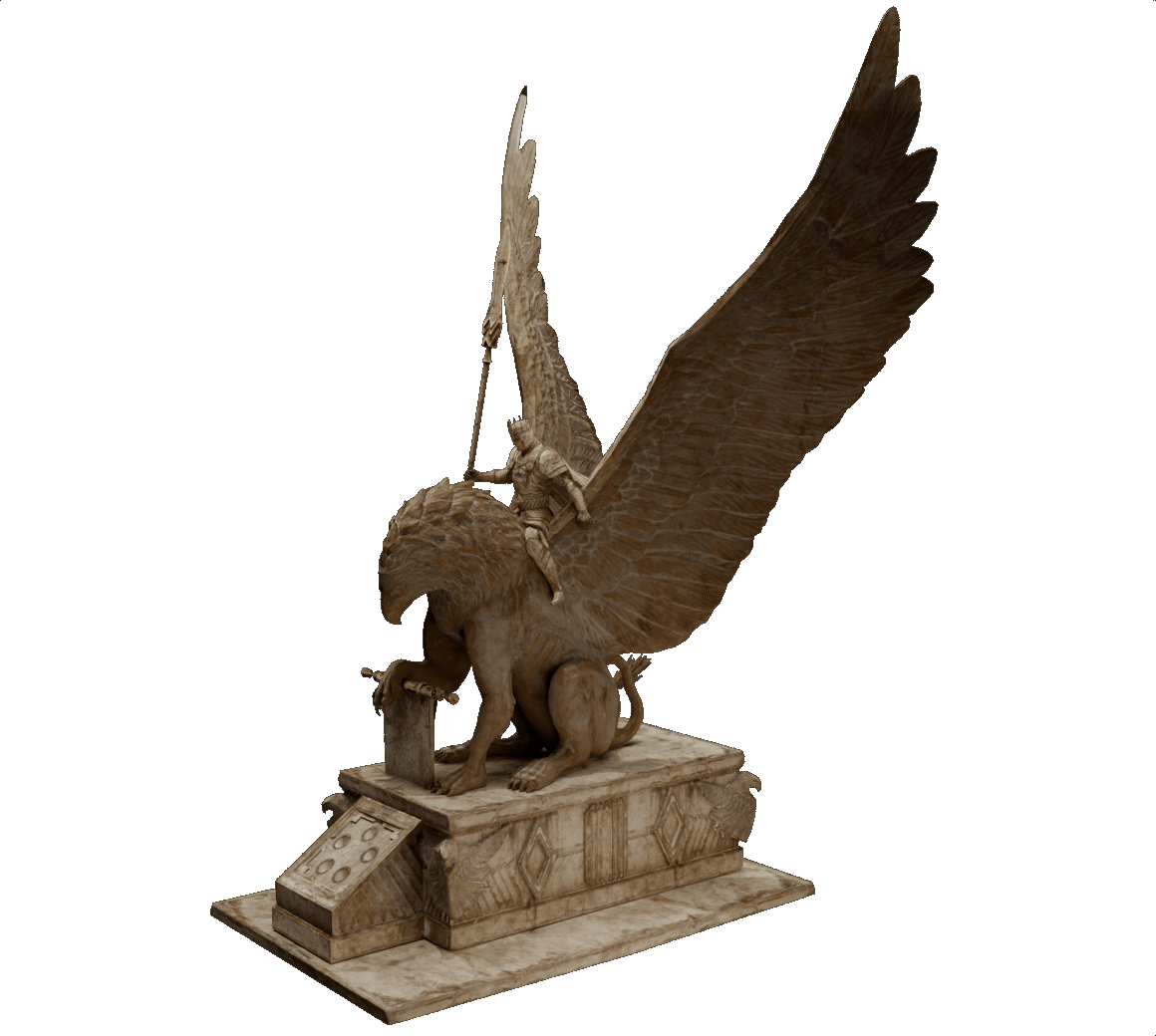 Blades Blades |
Vanus Galerion[edit] |
|
|
A statue of Vanus Galerion was found outside the Mages guildhall in Cheydinhal during the late-Third Era.[102]:359. Vanus is best remembered as the founder of the Mages Guild and one of the most famous practitioners of magic in the history of Tamriel.[103] He is depicted holding a torch and wears a long beard (contrary to his appearance during the mid-Second Era). |
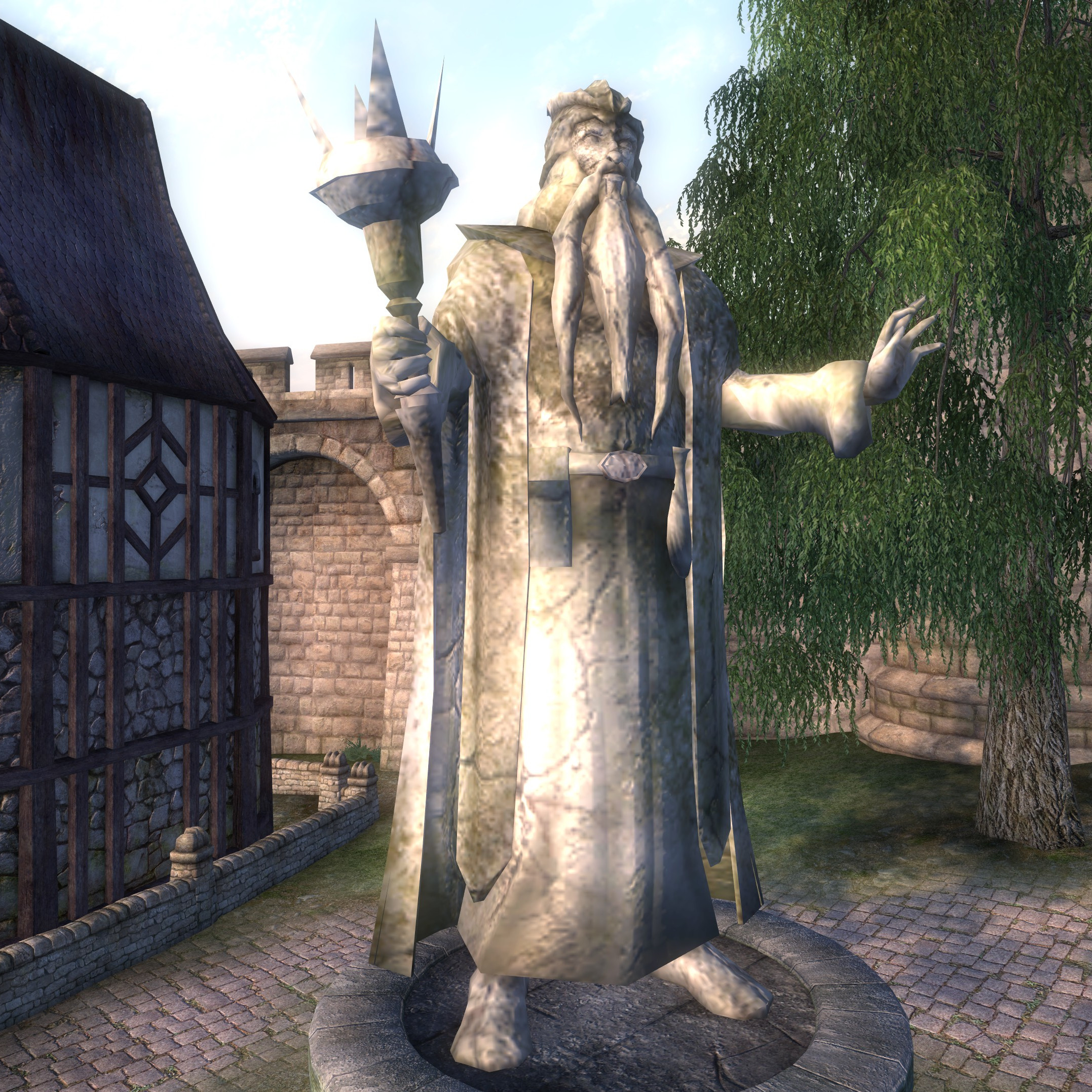 Oblivion Oblivion |
Vashu-Pir[edit] |
|
|
Vashu-Pir was one of the four greatest grandmasters of the Dragonguard in the late-First Era. He is remembered for defeating the dragon Laatvulon, alongside the Khajiiti hero Ja'darri.[104] After Vashu-Pir's death, a statue of him was built in Wind Scour Temple alongside the other great grandmasters.[105] During the return of Kaalgrontiid, Sai Sahan briefly traveled to the temple during his quest to learn the old ways of dragon slaying. Vashu-Pir's statue was discovered to be part of a mechanism that allowed Sai to reach the hidden Dragonguard archives, wherein he learned about the fabled Horn of Ja'darri.[33] |
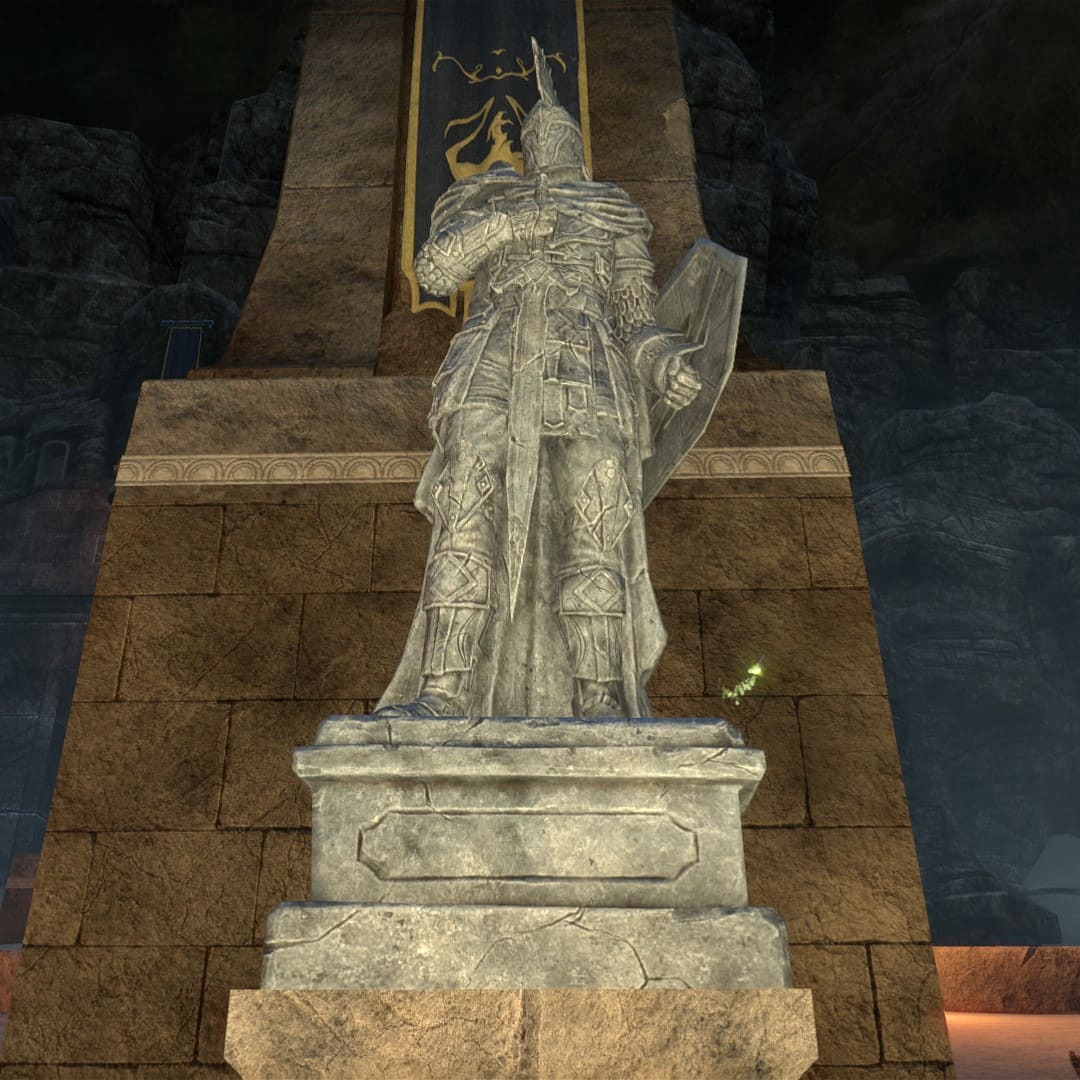 ESO ESO |
Viridian Sentinel[edit] |
|
|
A statue of a Viridian Sentinel wielding a bow stood in the forests of northern Bangkorai during the mid-Second Era. A Viridian Sentinel was a chosen individual who protected the inhabitants of the forests through a pact with Stendarr.[106][107] Statues of these guardians of the forest were also revered by the Glenmoril Wyrd around this time.[108] |
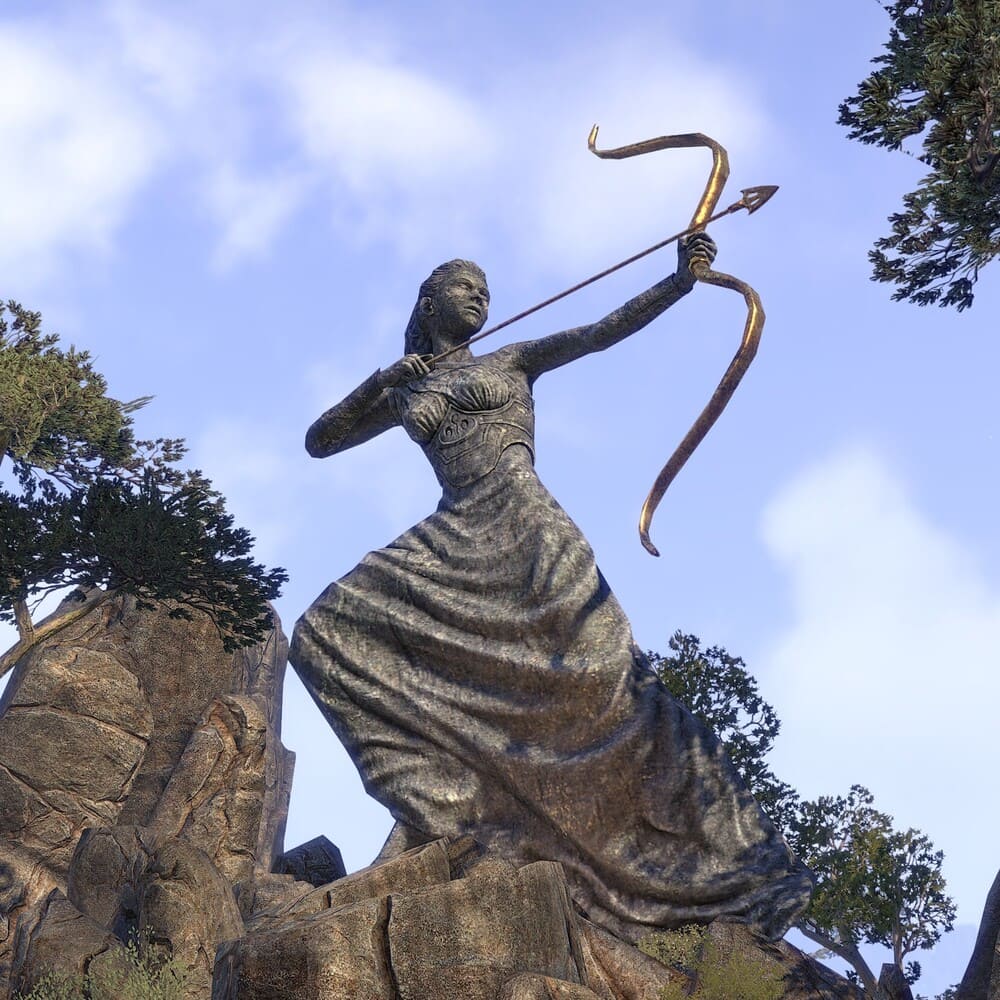 ESO ESO |
Ylgar and Yngol[edit] |
|
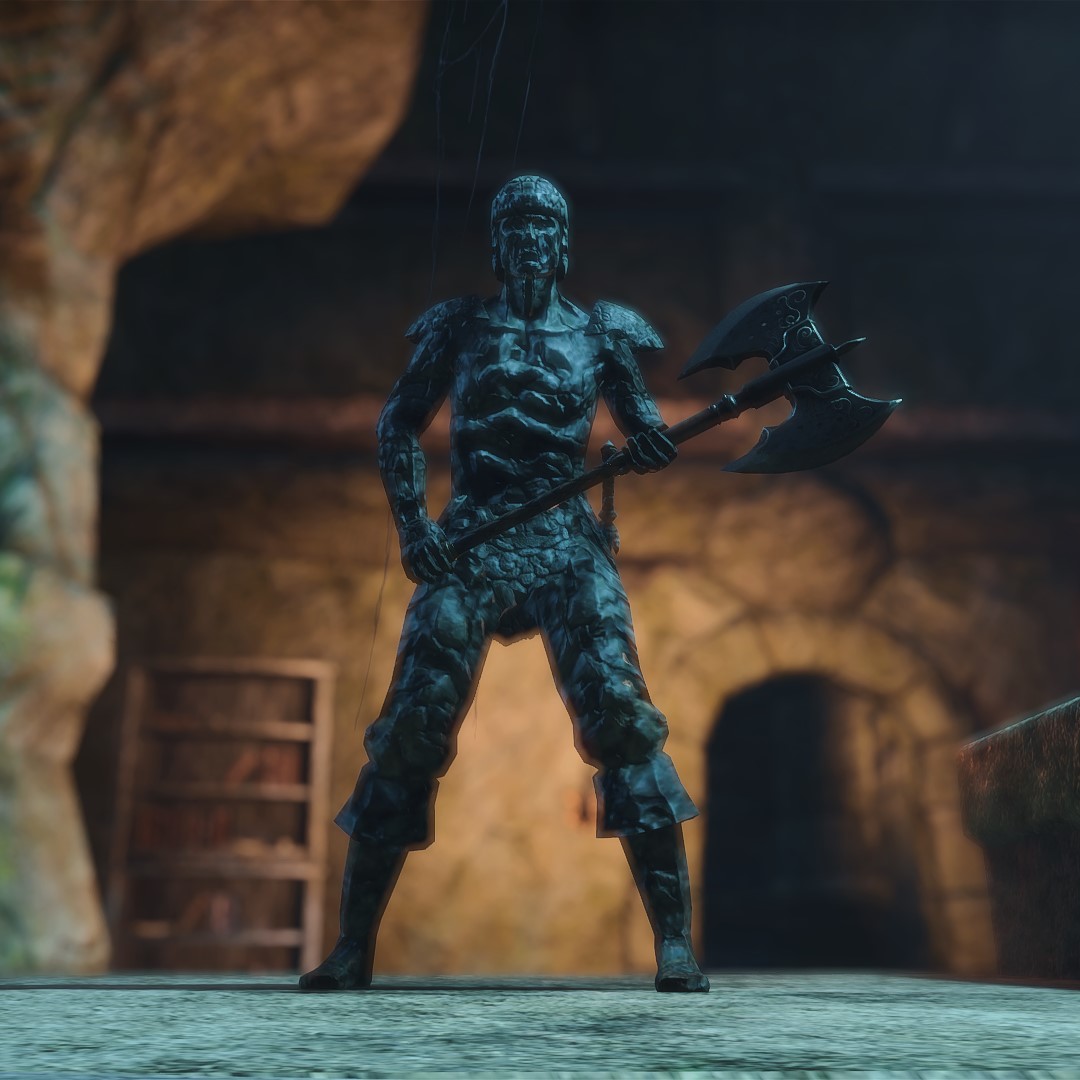 ESO |
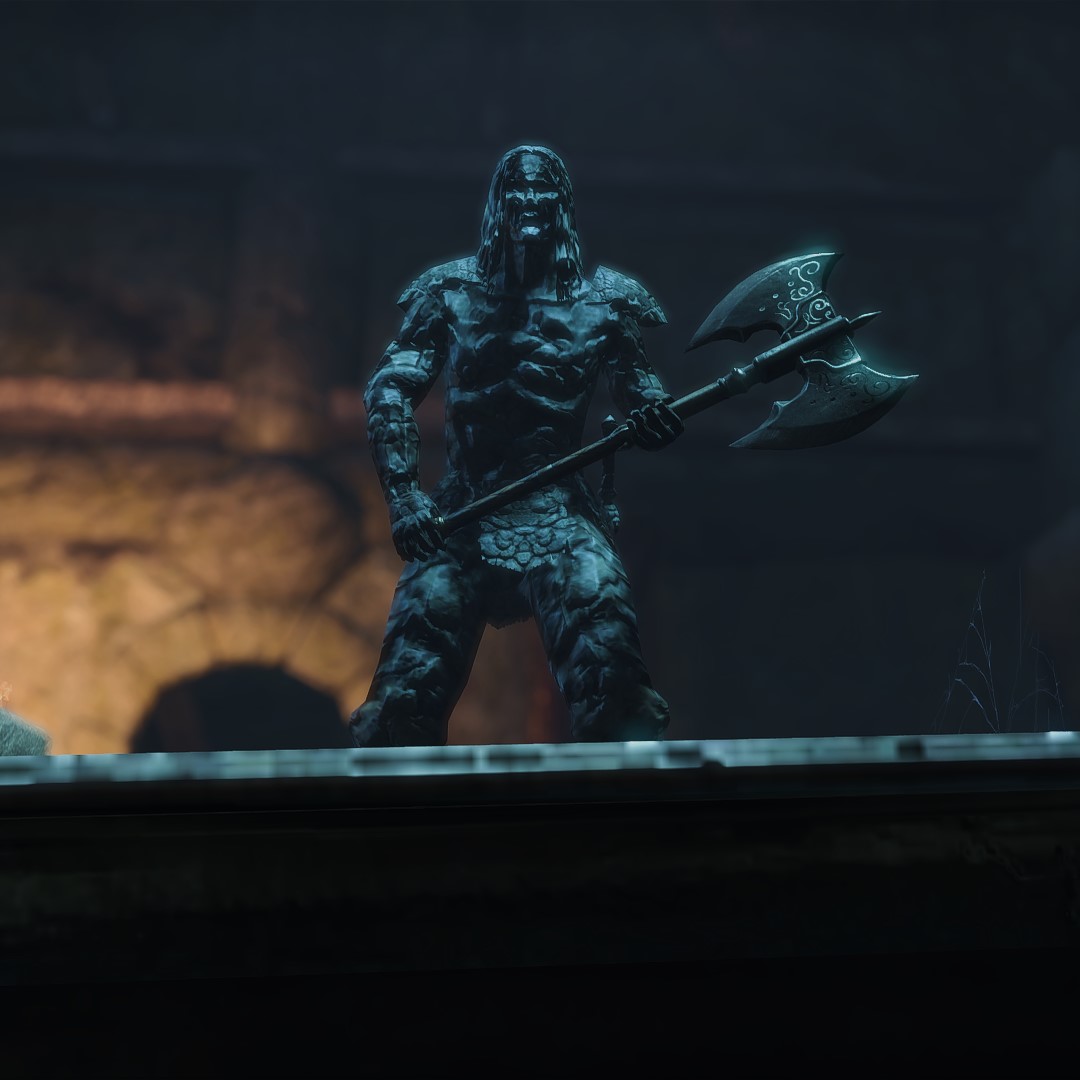 ESO |
|---|---|
|
Statues of Ysgramor's sons, Ylgar and Yngol, wielding battle-axes were built in the Companions' ancient headquarters of Fallowstone Hall. Within the Hall of the Dead were also various relics from the past, accompanied by plaques that describe their history.[109][110] |
|
Ysgramor[edit] |
|||
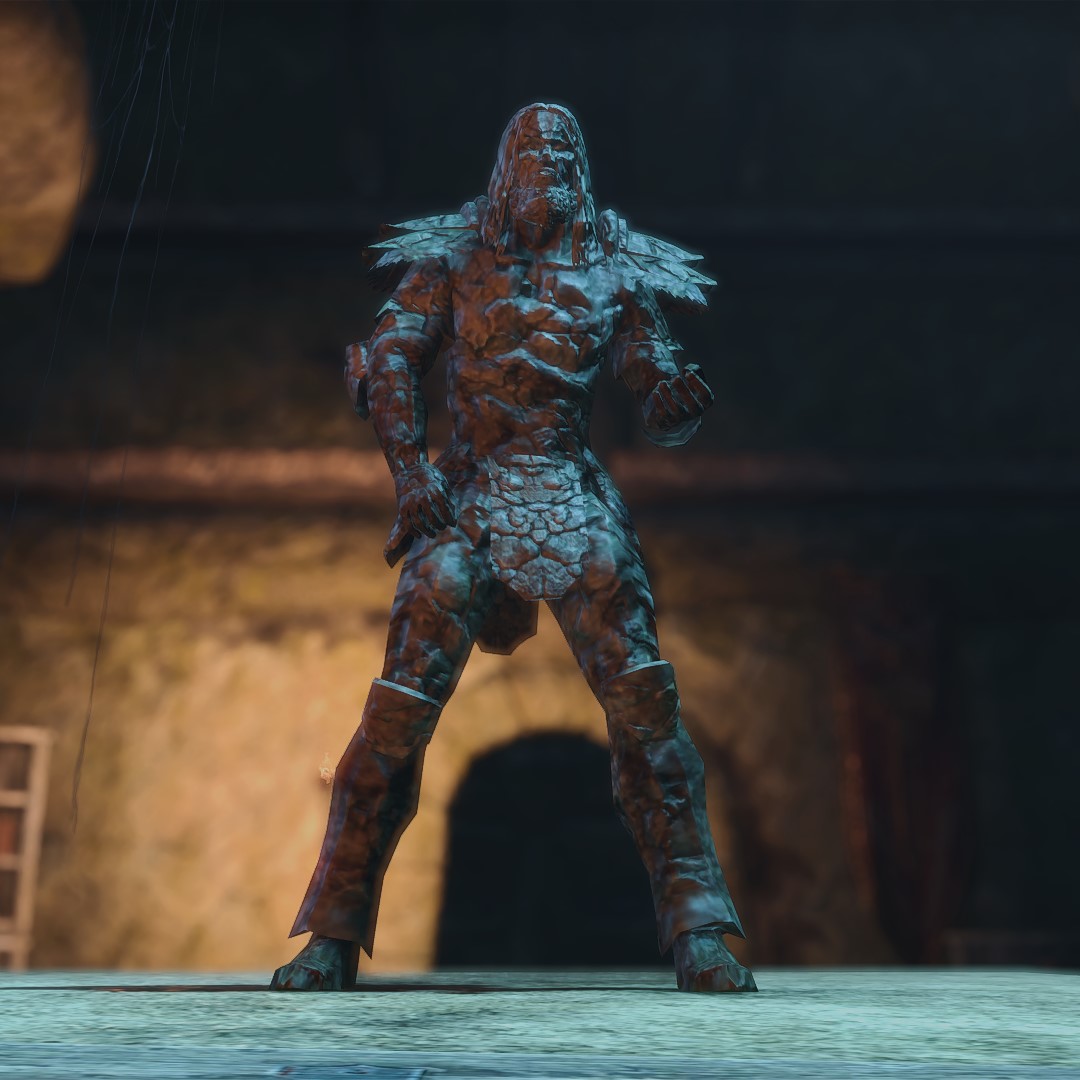 ESO ESO |
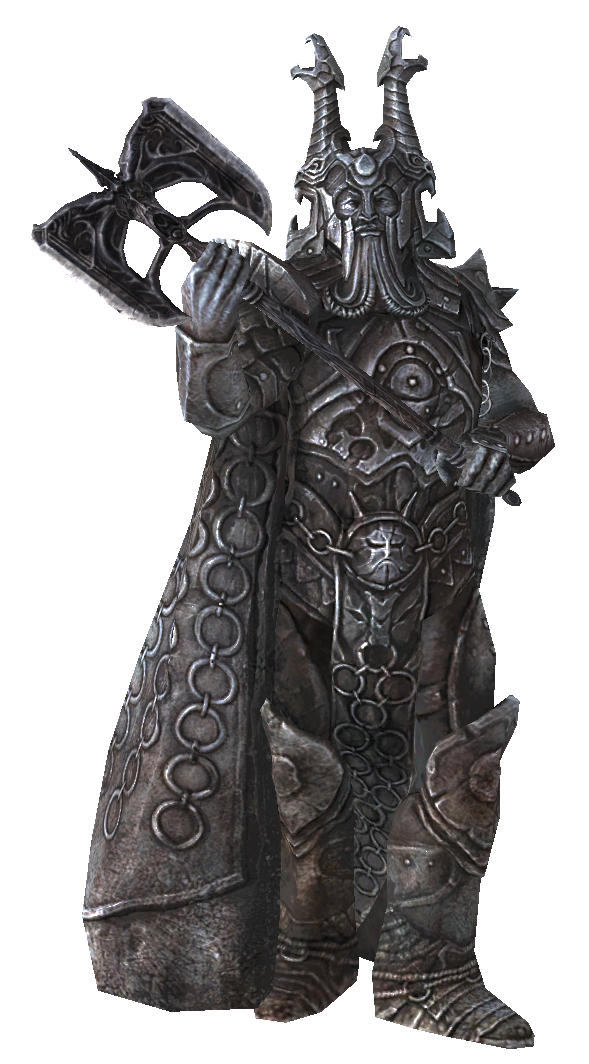 Skyrim Skyrim |
||
|---|---|---|---|
|
Statuary of Ysgramor has been linked to his legendary battleaxe, Wuuthrad, on at least two occasions. The first statue was erected in the Hall of Heroes, beneath Fallowstone Hall. It was here Ysgramor stood clutching Wuuthrad with the plaque mentioning the mighty axe of legend.[111] Fallowstone Hall was attacked by the Order of the Black Worm in 2E 582, led by the necromancer Thallik Wormfather, who stole Wuuthrad from the statue. Thallik sought to use Wuuthrad to reanimate the giant Sinmur and an army of his kin, but was ultimately defeated.[112][113] |
The second statue could be found in Ysgramor's Tomb on the northern coast of Skyrim. It was here the statue of the harbinger stood once again in a pose as if clutching Wuuthrad. The difference here was that Wuuthrad and the statue served as a locking mechanism for his tomb, so that when the Wuuthrad was placed in the statue's hands, the tomb would open. By the Fourth Era Wuuthrad had been shattered into pieces and the fragments were kept in the Companions' mead hall of Jorrvaskr. In 4E 201, Eorlund Gray-Mane was able to reforge the ancient weapon and, with the aid of the Last Dragonborn, the Companions were able to access the tomb of Ysgramor in an effort to cure their Lycanthropy.[114] |
||
 ESO ESO |
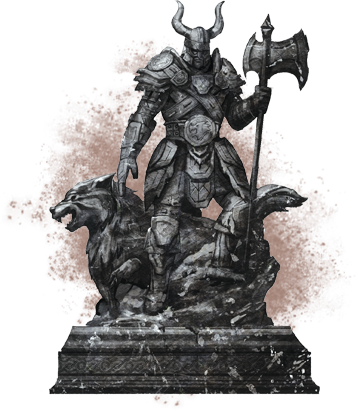 ESO ESO |
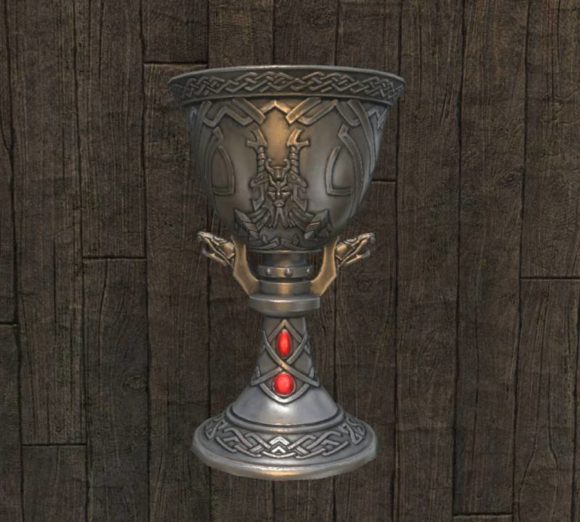 ESO ESO |
 ESO ESO |
|
Other statues of Ysgramor could be found across Skyrim, typically fully armored and wielding an axe.[115] Depictions of the harbinger were not limited to statuary and it is said his forebears likely adorned their weapons, armor and even silverware with his image, believing his face would lend legitimacy to any official act.[116] A mid-Second Era music box depicted a carved wooden miniature of Ysgramor and the five hundred companions aboard a longship.[117] |
|||
Notes[edit]
- ^ Morihaus was first introduced into the lore with the release of TES3: Morrowind, where he is described in Varieties of Faith... as an "Ancient cultural hero god of the Cyro-Nordics", but his race was undefined. In TES4: Oblivion he was described in Shezarr and the Divines as a "demigod" and "Morihaus-Breath-of-Kyne" and appeared human (based on the statue in the Arena District). It was only when the Oblivion add-on, Knights of the Nine, was released that his race was retroactively changed to a bull-man. This is noted in The Adabal-a and The Song of Pelinal where he is described as a "winged-bull" and "bull nephew". Due to this inconsistency, Kurt Kuhlmann and Michael Kirkbride joked that the statue would need to be retconned in the future.[UOL 1]
- ^ The book Knightsgrave: Legend or Legacy presents an inconsistency with the placement of these statues. It mentions that when the original founders of the order (Ennon Decan and his group of companions) died, great statues were raised in memory of the founders. This is also mentioned by the Black Dragon, who writes in her journal: "I admired the statues on the stairs that descended into these ruins. The founders of the Order of the Hour were great and faithful warriors.".
The inconsistency is that this book conflicts with what is presented in-game. When you visit Knightsgrave, four statues are indeed found on the stairs and main chamber, but instead of statues dedicated to Ennon Decan and his group (the original founders), we see statues dedicated to Cavor Merula and his group (the second founders). This is further complicated because although Cavor Merula re-established the Order, this book mentions he did not wish to use the 500-year-old crypts of Knightsgrave as a headquarters so as not to disturb the dead. He blessed the area, raised guardians, and left to build the Enclave of the Hourglass, which makes the existence of these statues (and associated brazier locks) somewhat of a paradox. - ^ The appearance of this statue can vary and is determined (and spawns) the moment you enter a new cell occupied by Martin after the Bruma great gate quest. This will usually be when you return to Cloud Ruler Temple, but it can happen on the road to it if you intercept him along the way. The armor and weapon on the statue will reflect the best quality items that you had in your inventory at the time, not necessarily the items that you had equipped. The game takes into account not just the value, but armor protection and enchantments.
References[edit]
- ^ St. Alessia, Paravant antiquity codex entry in ESO
- ^ The Elder Scrolls IV: Oblivion Official Game Guide — Peter Olafson — "Statue of Queen Alessia: First ruler of the Cyrodiilic Empire and Founder of the Nine Divines"
- ^ a b Appearance of statue in Oblivion
- ^ Shan-ra's dialogue in ESO
- ^ Flipping the Coin quest in ESO
- ^ a b Loading Screen in Oblivion
- ^ Kvatch's layout in ESO and Oblivion
- ^ The Refugees — Geros Albreigh
- ^ Online:Narsis Dren's dialogue in ESO
- ^ Draugr Dilemma quest in ESO
- ^ Lord Trystan's dialogue in ESO
- ^ a b The Ashes of Our Fathers quest in ESO
- ^ Lozruth's dialogue in ESO
- ^ a b The Colossus of Gonfalon Bay — Miramel Charascel, Chairperson of the Gonfalon Bay Historical and Social Society
- ^ Head of Brazzefk — Merethic Society
- ^ Statue of Sir Byric
- ^ Knights of the Flame Pup description in ESO
- ^ Aleris the Shroud
- ^ Crow Bringer
- ^ Hagrof the Righteous
- ^ The Thousand Arrows
- ^ Lucius the Stalwart
- ^ Whitebear
- ^ Ferian Darkstorm
- ^ Felhorn
- ^ Sanarel the Great
- ^ The Lava Queen
- ^ King's Sepulcher description in Blades
- ^ Bas-relief in Black Drake Villa
- ^ Grandmaster Ettiene Volusus
- ^ a b Sai Sahan's dialogue in ESO
- ^ a b c d The Dragonguard's Legacy quest in ESO
- ^ Trithik's dialogue in Redguard
- ^ Talisman of Hunding in Redguard
- ^ Grandmaster Ghelin-Brol
- ^ The Litany of Larceny quest in Skyrim
- ^ Hubalajad's Reflection in ESO: Thieves Guild
- ^ Lady in the Cistern: Zeira's Theory — Zeira
- ^ In Defense of Prince Hubalajad — Lady Cinnabar of Taneth
- ^ a b The Tomb of Ja'darri
- ^ Pridehome: A Place Outside Time? — Kaalaleth of the Mages Guild
- ^ Ja'darri's dialogue during The Dragonguard in ESO: Dragonhold
- ^ Nahfahlaar's dialogue in ESO: Dragonhold
- ^ Moon-Priest Nuziwa's dialogue in ESO: Dragonhold
- ^ Ja'darri the Endless
- ^ Grandmaster Jaiv-Yora
- ^ Appearance of statue in Skyrim
- ^ Brief History of the Empire v 2 — Stronach k'Thojj III
- ^ Kaalgrontiid's dialogue in ESO: Elsweyr
- ^ Cadwell's dialogue in ESO: Elsweyr
- ^ Khamira's dialogue in ESO: Elsweyr
- ^ Events of ESO: Elsweyr
- ^ Systres History: Volume 4 — Trilam Heladren, Associate Dean of Eltheric History, University of Gwylim
- ^ a b Golden Idol of Morihaus antiquity codex entry in ESO
- ^ Golden Morihaus Statuette treasure item in ESO
- ^ a b The Truth of Minotaurs — Tyronius Liore, Scholar of Imperial Antiquities
- ^ The Song of Pelinal, v 5
- ^ The Prophet's dialogue in Oblivion
- ^ On Minotaurs — Nonus Caprenius, Temporarily Unaffiliated Scholar of Imperial Antiquities
- ^ Belharza's Band antiquity codex entries in ESO
- ^ The Elder Scrolls IV: Oblivion Official Game Guide — Peter Olafson — "Statue of Pit Fighter Morihaus: Morihaus led St. Alessia's armies in the taking of the White Gold Tower and the overthrow of the Ayleid Hegemonies."
- ^ a b Ashaka's dialogue in ESO
- ^ Baloth Bloodtusk
- ^ Mazghar Many-Tongues
- ^ Lakora of the Hunt
- ^ Kinlord Nemfarion's dialogue in ESO: Summerset
- ^ Wasting Away quest in ESO: Summerset
- ^ The Black Dragon's Journal, Part 2 — The Black Dragon
- ^ Knightsgrave: Legend or Legacy — Chanter Wobolan, Cathedral Historian
- ^ Statue of Cavor Merula
- ^ Statue of Justia Desticus
- ^ Statue of Rusio Olo
- ^ Statue of Amminus Entius
- ^ The Elder Scrolls IV: Oblivion Official Game Guide — Peter Olafson — "Pelagius IV: Son of Tiber Septim"
- ^ Brief History of the Empire — Stronach k'Thojj III, Imperial Historian
- ^ Brief History of the Empire — Stronach k'Thojj III
- ^ Brief History of the Empire v 4 — Stronach k'Thojj III
- ^ The Elder Scrolls V: Skyrim: Prima Official Game Guide — David Hodgson — "The ancient Blades revered Reman Cyrodiil, and the whole place appears to be a shrine to him....You cut your palm, dripping blood into the floor seal, and Reman Cyrodiil's giant carved head lifts open."
- ^ Alduin's Wall quest in Skyrim
- ^ The Elder Scrolls IV: Oblivion Official Game Guide — Peter Olafson — "Statue of King Rislav Larich: Rislav the Righteous on his horse with his hawk on his hand."
- ^ Rislav The Righteous — Sinjin
- ^ Chronicles of the Five Companions 5 — Abnur Tharn
- ^ The Oblivion Crisis — Praxis Sarcorum, Imperial Historian
- ^ Great Gate quest in Oblivion
- ^ The Elder Scrolls V: Skyrim: Prima Official Game Guide — David Hodgson
- ^ A Minor Maze
- ^ Pocket Guide to the Empire, 1st Edition: Hammerfell — Imperial Geographical Society, 2E 864
- ^ Pocket Guide to the Empire, 3rd Edition: The Ra Gada: Hammerfell — Imperial Geographical Society, 3E 432
- ^ Introduction of Redguard
- ^ The Elder Scrolls IV: Oblivion Official Game Guide — Peter Olafson — "Statue of Torval the Pilot: The First Era High Elf explorer who charted the sea lanes around Tamriel and who discovered the River Niben."
- ^ Father Of The Niben — Florin Jaliil
- ^ Decentius Opsius' dialogue in Oblivion
- ^ The Elder Scrolls IV: Oblivion Official Game Guide — Peter Olafson — "Statue of Uriel Septim III:Commemorating Uriel III's victory in the War of the Red Diamond."
- ^ The mural in Valentis' tomb during A Tale of Two Brothers in Blades
- ^ Shulkunaak's dialogue in Blades
- ^ a b c Saashi's dialogue in Blades
- ^ Founder's Statue description in Blades
- ^ Telarendil's dialogue in Blades
- ^ Junius the Elder's dialogue in Blades
- ^ Wrath of the Sorcerer-King quest in Blades
- ^ The Elder Scrolls IV: Oblivion Official Game Guide — Peter Olafson — "Statue of Galerion the Mystic: Founder of the Mages Guild."
- ^ Galerion the Mystic — Asgrim Kolsgreg
- ^ Grandmaster Vashu-Pir Effigy quest item description in ESO
- ^ Grandmaster Vashu-Pir
- ^ The Viridian Sentinel
- ^ The Will of the Woods quest in ESO
- ^ The Improved Emperor's Guide to Tamriel: Northern Bangkorai and the Mountains — Flaccus Terentius, 2E 581
- ^ Fallowstone Hall loading screen in ESO
- ^ Vigrod Wraithbane's dialogue in ESO
- ^ Storming the Hall quest in ESO
- ^ The Rift questline in ESO
- ^ Thallik's Orders — Thallik Wormfather
- ^ Glory of the Dead quest in Skyrim
- ^ Ysgramor Statue furnishing in ESO
- ^ Sacred Chalice of Ysgramor antiquity codex entries in ESO
- ^ Hymn of Five-Hundred Axes music box in ESO
Note: The following references are considered to be unofficial sources. They are included to round off this article and may not be authoritative or conclusive.
|
||||||||||||||||||||||